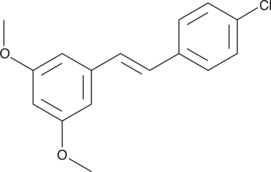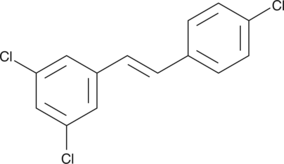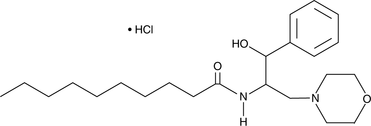Cayman
Showing 34351–34500 of 45550 results
-
The programmed death-1/programmed death-ligand 1 (PD-1/PD-L1) interaction plays a dominant role in the suppression of T cell responses, especially in a tumor microenvironment, protecting tumor cells from lysis.{30902} PD-1/PD-L1 inhibitor 2 is reported to prevent the interaction of PD-L1 with PD-1 with an IC50 value of 18 nM.{30903}
Brand:CaymanSKU:-Available on backorder
-
The programmed death-1/programmed death-ligand 1 (PD-1/PD-L1) interaction plays a dominant role in the suppression of T cell responses, especially in a tumor microenvironment, protecting tumor cells from lysis.{30902} PD-1/PD-L1 inhibitor 2 is reported to prevent the interaction of PD-L1 with PD-1 with an IC50 value of 18 nM.{30903}
Brand:CaymanSKU:-Available on backorder
-
The programmed death-1/programmed death-ligand 1 (PD-1/PD-L1) interaction plays a dominant role in the suppression of T cell responses, especially in a tumor microenvironment, protecting tumor cells from lysis.{30902} PD-1/PD-L1 inhibitor 2 is reported to prevent the interaction of PD-L1 with PD-1 with an IC50 value of 18 nM.{30903}
Brand:CaymanSKU:-Available on backorder
-
The programmed death-1/programmed death-ligand 1 (PD-1/PD-L1) interaction plays a dominant role in the suppression of T cell responses, especially in a tumor microenvironment, protecting tumor cells from lysis.{30902} PD-1/PD-L1 inhibitor 2 is reported to prevent the interaction of PD-L1 with PD-1 with an IC50 value of 18 nM.{30903}
Brand:CaymanSKU:-Available on backorder
-
PDD00017273 is a poly(ADP-ribose) glycohydrolase (PARG) inhibitor (IC50 = 26 nM in an enzyme assay).{32645} It maintains persistence of nuclear PAR chains in HeLa cells induced by the DNA damaging agent methylmethanesulfonate (MMS; IC50 = 37 nM). PDD00017273, in combination with MMS, increases nuclear phosphorylated H2AX (γH2AX) intensity, a marker of DNA double strand breaks, in MCF-7 cells in a concentration-dependent manner. It reduces clonogenic growth of ZR-75-1 and MDA-MB-436 cells but not HCC1937 cells (IC50s = 0.2, 0.8, and >10 μM, respectively).
Brand:CaymanSKU:-Available on backorder
-
PDD00017273 is a poly(ADP-ribose) glycohydrolase (PARG) inhibitor (IC50 = 26 nM in an enzyme assay).{32645} It maintains persistence of nuclear PAR chains in HeLa cells induced by the DNA damaging agent methylmethanesulfonate (MMS; IC50 = 37 nM). PDD00017273, in combination with MMS, increases nuclear phosphorylated H2AX (γH2AX) intensity, a marker of DNA double strand breaks, in MCF-7 cells in a concentration-dependent manner. It reduces clonogenic growth of ZR-75-1 and MDA-MB-436 cells but not HCC1937 cells (IC50s = 0.2, 0.8, and >10 μM, respectively).
Brand:CaymanSKU:-Available on backorder
-
PDDHV is a resiniferatoxin-type phorboid vanilloid with capsaicin-like selectivity for the cloned rat transient receptor potential cation channel subfamily V member 1 (TRPV1), formerly known as vanilloid receptor 1.{32371} It induces Ca2+-uptake by rat dorsal root ganglion neurons with an EC50 value of 70 nM.{32371}
Brand:CaymanSKU:20445 -Available on backorder
-
PDDHV is a resiniferatoxin-type phorboid vanilloid with capsaicin-like selectivity for the cloned rat transient receptor potential cation channel subfamily V member 1 (TRPV1), formerly known as vanilloid receptor 1.{32371} It induces Ca2+-uptake by rat dorsal root ganglion neurons with an EC50 value of 70 nM.{32371}
Brand:CaymanSKU:20445 -Available on backorder
-
Antigen: Synthetic peptide from rat PDI conjugated to KLH • Host: Rabbit • Cross Reactivity: (+) Human, mouse, rat, canine, hamster, monkey, guinea pig, bovine, ovine, porcine, and Xenopus PDI • Application(s): ICC, IHC, IP, WB • PDI is involved in disulphide-bond formation via its oxidase activity and isomerization via its isomerase activity, as well as the reduction of disulphite bonds in proteins. Studies suggest BiP and PDI work together sequentially to increase oxidation of these proteins.
Brand:CaymanSKU:13025- 100 µlAvailable on backorder
-
Antigen: Synthetic peptide from rat PDI conjugated to KLH • Host: Rabbit • Cross Reactivity: (+) Human, mouse, rat, canine, hamster, monkey, guinea pig, bovine, ovine, porcine, and Xenopus PDI • Application(s): ICC, IHC, IP, WB • PDI is involved in disulphide-bond formation via its oxidase activity and isomerization via its isomerase activity, as well as the reduction of disulphite bonds in proteins. Studies suggest BiP and PDI work together sequentially to increase oxidation of these proteins.
Brand:CaymanSKU:13025- 100 µl -
The three dimensional structure of many extracellular proteins is stabilized by the formation of disulphide bonds. Studies suggest that a microsomal enzyme known as protein disulphide isomerase (PDI) is involved in disulphide-bond formation via its oxidase activity and isomerization via its isomerase activity, as well as the reduction of disulphite bonds in proteins.{16242} Studies suggest BiP and PDI work together sequentially to increase oxidation of these proteins.{16273,16274} PDI has also been found to function as a chaperone to prevent the aggregation of unfolded substrates, and serves as a subunit of prolyl 4-hydroxylase and microsomal triglyceride transferase.{16275,16276} PDI is an abundant 55 kDa protein located primarily in the ER, however studies have also proved its presence in the cytosol.{16272} PDI has the ability to reside in the ER permanently due to the highly conserved KDEL sequence at its carboxy-terminus.{16277} It uses carboxy-terminal KDEL as a retention signal, and this appears to be sufficient to reduce the secretion of proteins from the ER. This retention is reported to be mediated by a KDEL receptor.{16278}
Brand:CaymanSKU:13025 - 100 µlAvailable on backorder
-
Antigen: Synthetic peptide from rat PDI conjugated to KLH • Host: Rabbit • Cross Reactivity: (+) Human, mouse, rat, canine, hamster, monkey, guinea pig, bovine, ovine, porcine, and Xenopus PDI • Application(s): ICC, IHC, IP, WB • PDI is involved in disulphide-bond formation via its oxidase activity and isomerization via its isomerase activity, as well as the reduction of disulphite bonds in proteins. Studies suggest BiP and PDI work together sequentially to increase oxidation of these proteins.
Brand:CaymanSKU:13025- 25 µlAvailable on backorder
-
Antigen: Synthetic peptide from rat PDI conjugated to KLH • Host: Rabbit • Cross Reactivity: (+) Human, mouse, rat, canine, hamster, monkey, guinea pig, bovine, ovine, porcine, and Xenopus PDI • Application(s): ICC, IHC, IP, WB • PDI is involved in disulphide-bond formation via its oxidase activity and isomerization via its isomerase activity, as well as the reduction of disulphite bonds in proteins. Studies suggest BiP and PDI work together sequentially to increase oxidation of these proteins.
Brand:CaymanSKU:13025- 25 µl -
The three dimensional structure of many extracellular proteins is stabilized by the formation of disulphide bonds. Studies suggest that a microsomal enzyme known as protein disulphide isomerase (PDI) is involved in disulphide-bond formation via its oxidase activity and isomerization via its isomerase activity, as well as the reduction of disulphite bonds in proteins.{16242} Studies suggest BiP and PDI work together sequentially to increase oxidation of these proteins.{16273,16274} PDI has also been found to function as a chaperone to prevent the aggregation of unfolded substrates, and serves as a subunit of prolyl 4-hydroxylase and microsomal triglyceride transferase.{16275,16276} PDI is an abundant 55 kDa protein located primarily in the ER, however studies have also proved its presence in the cytosol.{16272} PDI has the ability to reside in the ER permanently due to the highly conserved KDEL sequence at its carboxy-terminus.{16277} It uses carboxy-terminal KDEL as a retention signal, and this appears to be sufficient to reduce the secretion of proteins from the ER. This retention is reported to be mediated by a KDEL receptor.{16278}
Brand:CaymanSKU:13025 - 25 µlAvailable on backorder
-
PDM 11 is a derivative of the antioxidant trans-resveratrol that is inactive in vitro in assays of resveratrol activity.{39956} It does not activate quinone reductase 1, inhibit quinone reductase 2, or affect nitric oxide production or quenching of free radicals. It does not interact with estrogen receptors or affect the activity of COX-1 and COX-2. PDM 11 does not affect proliferation of K562, HT-29, and HepG2 cells.{39957}
Brand:CaymanSKU:10006341 - 10 mgAvailable on backorder
-
PDM 11 is a derivative of the antioxidant trans-resveratrol that is inactive in vitro in assays of resveratrol activity.{39956} It does not activate quinone reductase 1, inhibit quinone reductase 2, or affect nitric oxide production or quenching of free radicals. It does not interact with estrogen receptors or affect the activity of COX-1 and COX-2. PDM 11 does not affect proliferation of K562, HT-29, and HepG2 cells.{39957}
Brand:CaymanSKU:10006341 - 100 mgAvailable on backorder
-
PDM 11 is a derivative of the antioxidant trans-resveratrol that is inactive in vitro in assays of resveratrol activity.{39956} It does not activate quinone reductase 1, inhibit quinone reductase 2, or affect nitric oxide production or quenching of free radicals. It does not interact with estrogen receptors or affect the activity of COX-1 and COX-2. PDM 11 does not affect proliferation of K562, HT-29, and HepG2 cells.{39957}
Brand:CaymanSKU:10006341 - 25 mgAvailable on backorder
-
PDM 11 is a derivative of the antioxidant trans-resveratrol that is inactive in vitro in assays of resveratrol activity.{39956} It does not activate quinone reductase 1, inhibit quinone reductase 2, or affect nitric oxide production or quenching of free radicals. It does not interact with estrogen receptors or affect the activity of COX-1 and COX-2. PDM 11 does not affect proliferation of K562, HT-29, and HepG2 cells.{39957}
Brand:CaymanSKU:10006341 - 50 mgAvailable on backorder
-
The aryl hydrocarbon receptor (AhR) is a ligand-dependent intracellular transcription factor whose ligands include some of the most infamous xenobiotics, including dioxin, benzo[a]pyrene, and numerous polyaromatics from soot and coal tar.{12907} PDM 2 is an analog of resveratrol acting as a potent and selective aryl hydrocarbon receptor (AhR) antagonist, with a Ki of 1.2 nM.{12475} PDM 2 is inactive as a ligand for the estrogen receptor even at 100 µM. As AhR knockout mice are insensitive to the carcinogenic effects of classical AhR ligands, PDM 2 is a potential therapeutic for the treatment for dioxin and other aryl hydrocarbon poisonings.
Brand:CaymanSKU:10006342 - 10 mgAvailable on backorder
-
The aryl hydrocarbon receptor (AhR) is a ligand-dependent intracellular transcription factor whose ligands include some of the most infamous xenobiotics, including dioxin, benzo[a]pyrene, and numerous polyaromatics from soot and coal tar.{12907} PDM 2 is an analog of resveratrol acting as a potent and selective aryl hydrocarbon receptor (AhR) antagonist, with a Ki of 1.2 nM.{12475} PDM 2 is inactive as a ligand for the estrogen receptor even at 100 µM. As AhR knockout mice are insensitive to the carcinogenic effects of classical AhR ligands, PDM 2 is a potential therapeutic for the treatment for dioxin and other aryl hydrocarbon poisonings.
Brand:CaymanSKU:10006342 - 100 mgAvailable on backorder
-
The aryl hydrocarbon receptor (AhR) is a ligand-dependent intracellular transcription factor whose ligands include some of the most infamous xenobiotics, including dioxin, benzo[a]pyrene, and numerous polyaromatics from soot and coal tar.{12907} PDM 2 is an analog of resveratrol acting as a potent and selective aryl hydrocarbon receptor (AhR) antagonist, with a Ki of 1.2 nM.{12475} PDM 2 is inactive as a ligand for the estrogen receptor even at 100 µM. As AhR knockout mice are insensitive to the carcinogenic effects of classical AhR ligands, PDM 2 is a potential therapeutic for the treatment for dioxin and other aryl hydrocarbon poisonings.
Brand:CaymanSKU:10006342 - 50 mgAvailable on backorder
-
PDMP is a ceramide analog first prepared in a search for inhibitors of glucosylceramide synthase.{11392} PDMP has two adjacent chiral centers (C1 and C2) allowing for the formation of four possible isomers. PDMP contains all four of these stereoisomers. PDMP inhibits glucosylceramide synthase by 90% when used at a concentration of 0.8 μM in MDCK cell homogenates, however, the ability to inhibit glucosylceramide synthase has been found to reside in the D-threo (1R,2R) enantiomer.{11393} The D-threo PDMP enantiomer is also responsible for inhibition of β-1,4-galactosyltransferase 6 and prevention of lactosylceramide synthesis, which is a promotor of neuroinflammation in mice during chronic experimental autoimmune encephalomyelitis (EAE), a model of multiple sclerosis.{27728} PDMP enhances curcumin-induced inhibition of proliferation, JNK activation, and Akt inhibition, as well as induction of apoptosis in WM-115 melanoma cells in vitro.{42422}
Brand:CaymanSKU:62595 - 10 mgAvailable on backorder
-
PDMP is a ceramide analog first prepared in a search for inhibitors of glucosylceramide synthase.{11392} PDMP has two adjacent chiral centers (C1 and C2) allowing for the formation of four possible isomers. PDMP contains all four of these stereoisomers. PDMP inhibits glucosylceramide synthase by 90% when used at a concentration of 0.8 μM in MDCK cell homogenates, however, the ability to inhibit glucosylceramide synthase has been found to reside in the D-threo (1R,2R) enantiomer.{11393} The D-threo PDMP enantiomer is also responsible for inhibition of β-1,4-galactosyltransferase 6 and prevention of lactosylceramide synthesis, which is a promotor of neuroinflammation in mice during chronic experimental autoimmune encephalomyelitis (EAE), a model of multiple sclerosis.{27728} PDMP enhances curcumin-induced inhibition of proliferation, JNK activation, and Akt inhibition, as well as induction of apoptosis in WM-115 melanoma cells in vitro.{42422}
Brand:CaymanSKU:62595 - 100 mgAvailable on backorder
-
PDMP is a ceramide analog first prepared in a search for inhibitors of glucosylceramide synthase.{11392} PDMP has two adjacent chiral centers (C1 and C2) allowing for the formation of four possible isomers. PDMP contains all four of these stereoisomers. PDMP inhibits glucosylceramide synthase by 90% when used at a concentration of 0.8 μM in MDCK cell homogenates, however, the ability to inhibit glucosylceramide synthase has been found to reside in the D-threo (1R,2R) enantiomer.{11393} The D-threo PDMP enantiomer is also responsible for inhibition of β-1,4-galactosyltransferase 6 and prevention of lactosylceramide synthesis, which is a promotor of neuroinflammation in mice during chronic experimental autoimmune encephalomyelitis (EAE), a model of multiple sclerosis.{27728} PDMP enhances curcumin-induced inhibition of proliferation, JNK activation, and Akt inhibition, as well as induction of apoptosis in WM-115 melanoma cells in vitro.{42422}
Brand:CaymanSKU:62595 - 25 mgAvailable on backorder
-
PDMP is a ceramide analog first prepared in a search for inhibitors of glucosylceramide synthase.{11392} PDMP has two adjacent chiral centers (C1 and C2) allowing for the formation of four possible isomers. PDMP contains all four of these stereoisomers. PDMP inhibits glucosylceramide synthase by 90% when used at a concentration of 0.8 μM in MDCK cell homogenates, however, the ability to inhibit glucosylceramide synthase has been found to reside in the D-threo (1R,2R) enantiomer.{11393} The D-threo PDMP enantiomer is also responsible for inhibition of β-1,4-galactosyltransferase 6 and prevention of lactosylceramide synthesis, which is a promotor of neuroinflammation in mice during chronic experimental autoimmune encephalomyelitis (EAE), a model of multiple sclerosis.{27728} PDMP enhances curcumin-induced inhibition of proliferation, JNK activation, and Akt inhibition, as well as induction of apoptosis in WM-115 melanoma cells in vitro.{42422}
Brand:CaymanSKU:62595 - 50 mgAvailable on backorder
-
PDPEA is an enhancer of fatty acid amide hydrolase (FAAH) activity.{56137} It blocks inhibition of recombinant A. thaliana or rat FAAH activity induced by N-acylethanolamine 12:0 (NAE 12:0) when used at a concentration of 100 µM. PDPEA (20 µM) inhibits NAE 12:0-induced decreases in cotyledon size in A. thaliana seedlings.
Brand:CaymanSKU:30956 - 1 mgAvailable on backorder
-
PDPEA is an enhancer of fatty acid amide hydrolase (FAAH) activity.{56137} It blocks inhibition of recombinant A. thaliana or rat FAAH activity induced by N-acylethanolamine 12:0 (NAE 12:0) when used at a concentration of 100 µM. PDPEA (20 µM) inhibits NAE 12:0-induced decreases in cotyledon size in A. thaliana seedlings.
Brand:CaymanSKU:30956 - 10 mgAvailable on backorder
-
PDPEA is an enhancer of fatty acid amide hydrolase (FAAH) activity.{56137} It blocks inhibition of recombinant A. thaliana or rat FAAH activity induced by N-acylethanolamine 12:0 (NAE 12:0) when used at a concentration of 100 µM. PDPEA (20 µM) inhibits NAE 12:0-induced decreases in cotyledon size in A. thaliana seedlings.
Brand:CaymanSKU:30956 - 5 mgAvailable on backorder
-
Peficitinib is an inhibitor of JAK (IC50s = 3.9, 5, and 0.71 nM for JAK1-3, respectively).{36733} It is 14-fold selective for JAK1 and JAK3 over JAK2 in erythropoietin-induced leukemia cell proliferation assays. Peficitinib inhibits IL-2-induced proliferation of rat splenocytes (IC50 = 10 nM) and phosphorylation of STAT5 in rat and human whole blood (IC50s = 124 and 127 nM, respectively).{36734} In vivo, peficitinib reduces paw swelling (ED50 = 5.6 mg/kg) and bone destruction in a rat model of adjuvant-induced arthritis when administered at a dose of 30 mg/kg.
Brand:CaymanSKU:22954 - 1 mgAvailable on backorder
-
Peficitinib is an inhibitor of JAK (IC50s = 3.9, 5, and 0.71 nM for JAK1-3, respectively).{36733} It is 14-fold selective for JAK1 and JAK3 over JAK2 in erythropoietin-induced leukemia cell proliferation assays. Peficitinib inhibits IL-2-induced proliferation of rat splenocytes (IC50 = 10 nM) and phosphorylation of STAT5 in rat and human whole blood (IC50s = 124 and 127 nM, respectively).{36734} In vivo, peficitinib reduces paw swelling (ED50 = 5.6 mg/kg) and bone destruction in a rat model of adjuvant-induced arthritis when administered at a dose of 30 mg/kg.
Brand:CaymanSKU:22954 - 10 mgAvailable on backorder
-
Peficitinib is an inhibitor of JAK (IC50s = 3.9, 5, and 0.71 nM for JAK1-3, respectively).{36733} It is 14-fold selective for JAK1 and JAK3 over JAK2 in erythropoietin-induced leukemia cell proliferation assays. Peficitinib inhibits IL-2-induced proliferation of rat splenocytes (IC50 = 10 nM) and phosphorylation of STAT5 in rat and human whole blood (IC50s = 124 and 127 nM, respectively).{36734} In vivo, peficitinib reduces paw swelling (ED50 = 5.6 mg/kg) and bone destruction in a rat model of adjuvant-induced arthritis when administered at a dose of 30 mg/kg.
Brand:CaymanSKU:22954 - 5 mgAvailable on backorder
-
Pefloxacin is a broad-spectrum and synthetic fluoroquinolone antibiotic and a methylated derivative of norfloxacin (Item No. 25975).{47756,47757} It is active against Gram-negative and Gram-positive bacteria, including clinical isolates of E. coli, K. pneumoniae, S. aureus, and G. vaginalis (MIC90s = 0.12, 0.5, 0.5, and 32 mg/L, respectively).{47756,47757} Pefloxacin selectively inhibits E. coli topoisomerase I and DNA gyrase over calf thymus topoisomerase I (IC50s = 45, 4.5, and >140 μg/ml, respectively) in cell-free assays.{47758} In vivo, pefloxacin is active against systemic E. coli, K. pneumoniae, and P. aeruginosa infections in mice with 50% of efficacy maximum (P50) values of 6.5, 29.2, and 219 mg/kg, respectively.{47759}
Brand:CaymanSKU:29103 - 10 gAvailable on backorder
-
Pefloxacin is a broad-spectrum and synthetic fluoroquinolone antibiotic and a methylated derivative of norfloxacin (Item No. 25975).{47756,47757} It is active against Gram-negative and Gram-positive bacteria, including clinical isolates of E. coli, K. pneumoniae, S. aureus, and G. vaginalis (MIC90s = 0.12, 0.5, 0.5, and 32 mg/L, respectively).{47756,47757} Pefloxacin selectively inhibits E. coli topoisomerase I and DNA gyrase over calf thymus topoisomerase I (IC50s = 45, 4.5, and >140 μg/ml, respectively) in cell-free assays.{47758} In vivo, pefloxacin is active against systemic E. coli, K. pneumoniae, and P. aeruginosa infections in mice with 50% of efficacy maximum (P50) values of 6.5, 29.2, and 219 mg/kg, respectively.{47759}
Brand:CaymanSKU:29103 - 100 gAvailable on backorder
-
Pefloxacin is a broad-spectrum and synthetic fluoroquinolone antibiotic and a methylated derivative of norfloxacin (Item No. 25975).{47756,47757} It is active against Gram-negative and Gram-positive bacteria, including clinical isolates of E. coli, K. pneumoniae, S. aureus, and G. vaginalis (MIC90s = 0.12, 0.5, 0.5, and 32 mg/L, respectively).{47756,47757} Pefloxacin selectively inhibits E. coli topoisomerase I and DNA gyrase over calf thymus topoisomerase I (IC50s = 45, 4.5, and >140 μg/ml, respectively) in cell-free assays.{47758} In vivo, pefloxacin is active against systemic E. coli, K. pneumoniae, and P. aeruginosa infections in mice with 50% of efficacy maximum (P50) values of 6.5, 29.2, and 219 mg/kg, respectively.{47759}
Brand:CaymanSKU:29103 - 25 gAvailable on backorder
-
Pefloxacin is a broad-spectrum and synthetic fluoroquinolone antibiotic and a methylated derivative of norfloxacin (Item No. 25975).{47756,47757} It is active against Gram-negative and Gram-positive bacteria, including clinical isolates of E. coli, K. pneumoniae, S. aureus, and G. vaginalis (MIC90s = 0.12, 0.5, 0.5, and 32 mg/L, respectively).{47756,47757} Pefloxacin selectively inhibits E. coli topoisomerase I and DNA gyrase over calf thymus topoisomerase I (IC50s = 45, 4.5, and >140 μg/ml, respectively) in cell-free assays.{47758} In vivo, pefloxacin is active against systemic E. coli, K. pneumoniae, and P. aeruginosa infections in mice with 50% of efficacy maximum (P50) values of 6.5, 29.2, and 219 mg/kg, respectively.{47759}
Brand:CaymanSKU:29103 - 50 gAvailable on backorder
-
Peimine is an alkaloid that has been found in Fritillaria and has diverse biological activities, including ion channel inhibitory, anti-tussive, anticancer, and anti-inflammatory properties.{53420,56003,56004,56005,56006} It is an inhibitor of voltage-gated sodium channel 1.7 (Nav1.7; IC50= 47.2 µM) and human-ether-a-go-go (hERG), also known as Kv11.1 (IC50 = 43.7 µM).{56003,56004} It increases the latent period of coughs, decreases the number of coughs, and has expectorant activity in a mouse model of ammonia liquor-induced cough when administered at a dose of 3 mg/kg.{53420} Peimine (2.5, 5, and 10 µM) inhibits the growth of DU145, LNCaP, and PC3 prostate cancer, but not RWPE-1 non-cancerous, cells.{56005} It also induces phosphorylation of calcium/calmodulin-dependent protein kinase II (CaMKII) in, and apoptosis of, PC3 cells and inhibits PC3 cell invasion, migration, and epithelial-to-mesenchymal transition. Peimine (10, 20, or 50 mg/animal) reduces tumor growth in a PC3 mouse xenograft model. It decreases IL-1β-induced nitric oxide (NO) and prostaglandin E2 (PGE2; Item No. 14010) production and reduces inducible NO synthase (iNOS) and COX-2 protein levels in primary mouse articular chondrocytes in vitro.{56006} It also decreases the severity of osteoarthritis-associated histopathological alterations in a mouse model of osteoarthritis when administered at a dose of 20 mg/kg.
Brand:CaymanSKU:29963 - 10 mgAvailable on backorder
-
Peimine is an alkaloid that has been found in Fritillaria and has diverse biological activities, including ion channel inhibitory, anti-tussive, anticancer, and anti-inflammatory properties.{53420,56003,56004,56005,56006} It is an inhibitor of voltage-gated sodium channel 1.7 (Nav1.7; IC50= 47.2 µM) and human-ether-a-go-go (hERG), also known as Kv11.1 (IC50 = 43.7 µM).{56003,56004} It increases the latent period of coughs, decreases the number of coughs, and has expectorant activity in a mouse model of ammonia liquor-induced cough when administered at a dose of 3 mg/kg.{53420} Peimine (2.5, 5, and 10 µM) inhibits the growth of DU145, LNCaP, and PC3 prostate cancer, but not RWPE-1 non-cancerous, cells.{56005} It also induces phosphorylation of calcium/calmodulin-dependent protein kinase II (CaMKII) in, and apoptosis of, PC3 cells and inhibits PC3 cell invasion, migration, and epithelial-to-mesenchymal transition. Peimine (10, 20, or 50 mg/animal) reduces tumor growth in a PC3 mouse xenograft model. It decreases IL-1β-induced nitric oxide (NO) and prostaglandin E2 (PGE2; Item No. 14010) production and reduces inducible NO synthase (iNOS) and COX-2 protein levels in primary mouse articular chondrocytes in vitro.{56006} It also decreases the severity of osteoarthritis-associated histopathological alterations in a mouse model of osteoarthritis when administered at a dose of 20 mg/kg.
Brand:CaymanSKU:29963 - 25 mgAvailable on backorder
-
Peimine is an alkaloid that has been found in Fritillaria and has diverse biological activities, including ion channel inhibitory, anti-tussive, anticancer, and anti-inflammatory properties.{53420,56003,56004,56005,56006} It is an inhibitor of voltage-gated sodium channel 1.7 (Nav1.7; IC50= 47.2 µM) and human-ether-a-go-go (hERG), also known as Kv11.1 (IC50 = 43.7 µM).{56003,56004} It increases the latent period of coughs, decreases the number of coughs, and has expectorant activity in a mouse model of ammonia liquor-induced cough when administered at a dose of 3 mg/kg.{53420} Peimine (2.5, 5, and 10 µM) inhibits the growth of DU145, LNCaP, and PC3 prostate cancer, but not RWPE-1 non-cancerous, cells.{56005} It also induces phosphorylation of calcium/calmodulin-dependent protein kinase II (CaMKII) in, and apoptosis of, PC3 cells and inhibits PC3 cell invasion, migration, and epithelial-to-mesenchymal transition. Peimine (10, 20, or 50 mg/animal) reduces tumor growth in a PC3 mouse xenograft model. It decreases IL-1β-induced nitric oxide (NO) and prostaglandin E2 (PGE2; Item No. 14010) production and reduces inducible NO synthase (iNOS) and COX-2 protein levels in primary mouse articular chondrocytes in vitro.{56006} It also decreases the severity of osteoarthritis-associated histopathological alterations in a mouse model of osteoarthritis when administered at a dose of 20 mg/kg.
Brand:CaymanSKU:29963 - 5 mgAvailable on backorder
-
Peimine is an alkaloid that has been found in Fritillaria and has diverse biological activities, including ion channel inhibitory, anti-tussive, anticancer, and anti-inflammatory properties.{53420,56003,56004,56005,56006} It is an inhibitor of voltage-gated sodium channel 1.7 (Nav1.7; IC50= 47.2 µM) and human-ether-a-go-go (hERG), also known as Kv11.1 (IC50 = 43.7 µM).{56003,56004} It increases the latent period of coughs, decreases the number of coughs, and has expectorant activity in a mouse model of ammonia liquor-induced cough when administered at a dose of 3 mg/kg.{53420} Peimine (2.5, 5, and 10 µM) inhibits the growth of DU145, LNCaP, and PC3 prostate cancer, but not RWPE-1 non-cancerous, cells.{56005} It also induces phosphorylation of calcium/calmodulin-dependent protein kinase II (CaMKII) in, and apoptosis of, PC3 cells and inhibits PC3 cell invasion, migration, and epithelial-to-mesenchymal transition. Peimine (10, 20, or 50 mg/animal) reduces tumor growth in a PC3 mouse xenograft model. It decreases IL-1β-induced nitric oxide (NO) and prostaglandin E2 (PGE2; Item No. 14010) production and reduces inducible NO synthase (iNOS) and COX-2 protein levels in primary mouse articular chondrocytes in vitro.{56006} It also decreases the severity of osteoarthritis-associated histopathological alterations in a mouse model of osteoarthritis when administered at a dose of 20 mg/kg.
Brand:CaymanSKU:29963 - 50 mgAvailable on backorder
-
Peiminine is an alkaloid that has been found in Fritillaria and has diverse biological activities.{53419,53420,53421} It increases protein levels of the autophagy marker LC3B-II and induces cell death in HCT116 colorectal carcinoma cells in a concentration-dependent manner.{53419} Peiminine (3 mg/kg every other day) reduces tumor growth in an HCT116 mouse xenograft model. It has antitussive effects in a mouse cough model induced by ammonia liquor when administered at a dose of 3 mg/kg.{53420} Peiminine (5 mg/kg) reduces dermal and epidermal thickness, inhibits dermal infiltration of eosinophils and mast cells, and decreases serum levels of IgE, IL-4, and TNF-α in a mouse model of atopic dermatitis induced by dinitrochlorobenzene (DNCB).{53421}
Brand:CaymanSKU:29618 - 10 mgAvailable on backorder
-
Peiminine is an alkaloid that has been found in Fritillaria and has diverse biological activities.{53419,53420,53421} It increases protein levels of the autophagy marker LC3B-II and induces cell death in HCT116 colorectal carcinoma cells in a concentration-dependent manner.{53419} Peiminine (3 mg/kg every other day) reduces tumor growth in an HCT116 mouse xenograft model. It has antitussive effects in a mouse cough model induced by ammonia liquor when administered at a dose of 3 mg/kg.{53420} Peiminine (5 mg/kg) reduces dermal and epidermal thickness, inhibits dermal infiltration of eosinophils and mast cells, and decreases serum levels of IgE, IL-4, and TNF-α in a mouse model of atopic dermatitis induced by dinitrochlorobenzene (DNCB).{53421}
Brand:CaymanSKU:29618 - 25 mgAvailable on backorder
-
Peiminine is an alkaloid that has been found in Fritillaria and has diverse biological activities.{53419,53420,53421} It increases protein levels of the autophagy marker LC3B-II and induces cell death in HCT116 colorectal carcinoma cells in a concentration-dependent manner.{53419} Peiminine (3 mg/kg every other day) reduces tumor growth in an HCT116 mouse xenograft model. It has antitussive effects in a mouse cough model induced by ammonia liquor when administered at a dose of 3 mg/kg.{53420} Peiminine (5 mg/kg) reduces dermal and epidermal thickness, inhibits dermal infiltration of eosinophils and mast cells, and decreases serum levels of IgE, IL-4, and TNF-α in a mouse model of atopic dermatitis induced by dinitrochlorobenzene (DNCB).{53421}
Brand:CaymanSKU:29618 - 5 mgAvailable on backorder
-
Peiminine is an alkaloid that has been found in Fritillaria and has diverse biological activities.{53419,53420,53421} It increases protein levels of the autophagy marker LC3B-II and induces cell death in HCT116 colorectal carcinoma cells in a concentration-dependent manner.{53419} Peiminine (3 mg/kg every other day) reduces tumor growth in an HCT116 mouse xenograft model. It has antitussive effects in a mouse cough model induced by ammonia liquor when administered at a dose of 3 mg/kg.{53420} Peiminine (5 mg/kg) reduces dermal and epidermal thickness, inhibits dermal infiltration of eosinophils and mast cells, and decreases serum levels of IgE, IL-4, and TNF-α in a mouse model of atopic dermatitis induced by dinitrochlorobenzene (DNCB).{53421}
Brand:CaymanSKU:29618 - 50 mgAvailable on backorder
-
Pelargonidin is an anthocyanidin that has been found in P. granatum and has diverse biological activities.{61058,61059,61060,61061} It scavenges superoxide anions in cell-free assays (IC50 = 130 µg/ml) and inhibits hydrogen peroxide-induced lipid peroxidation in rat brain homogenates (IC50 = 85 µM).{61058} Pelargonidin (3 mg/kg) reduces serum levels of alanine aminotransferase (ALT) and aspartate aminotransferase (AST), hepatocyte apoptosis, and hepatic levels of IL-1β, IL-6, TNF-α, and TGF-β in a mouse model of hepatotoxicity induced by acetaminophen (Item No. 10024).{61059} It increases survival and reduces pulmonary fibrosis and leukocyte infiltration in a mouse model of LPS-induced endotoxemia.{61060} Pelargonidin (0.04-0.4 mg/kg) reduces serum levels of nitric oxide (NO), TNF-α, and IL-6 and increases renal myeloperoxidase (MPO), superoxide dismutase (SOD), and catalase (CAT) activities, as well as increases survival, in a mouse model of cecal ligation and puncture-induced sepsis.{61061} It also decreases escape latency in the Morris water maze, reduces hippocampal malondialdehyde (MDA) levels, and increases hippocampal acetylcholinesterase (AChE) activity in a rat model of Alzheimer’s disease induced by amyloid-β 25-35 (Aβ (25-35); Item No. 24155).{61062}
Brand:CaymanSKU:19753 -Available on backorder
-
Pelargonidin is an anthocyanidin that has been found in P. granatum and has diverse biological activities.{61058,61059,61060,61061} It scavenges superoxide anions in cell-free assays (IC50 = 130 µg/ml) and inhibits hydrogen peroxide-induced lipid peroxidation in rat brain homogenates (IC50 = 85 µM).{61058} Pelargonidin (3 mg/kg) reduces serum levels of alanine aminotransferase (ALT) and aspartate aminotransferase (AST), hepatocyte apoptosis, and hepatic levels of IL-1β, IL-6, TNF-α, and TGF-β in a mouse model of hepatotoxicity induced by acetaminophen (Item No. 10024).{61059} It increases survival and reduces pulmonary fibrosis and leukocyte infiltration in a mouse model of LPS-induced endotoxemia.{61060} Pelargonidin (0.04-0.4 mg/kg) reduces serum levels of nitric oxide (NO), TNF-α, and IL-6 and increases renal myeloperoxidase (MPO), superoxide dismutase (SOD), and catalase (CAT) activities, as well as increases survival, in a mouse model of cecal ligation and puncture-induced sepsis.{61061} It also decreases escape latency in the Morris water maze, reduces hippocampal malondialdehyde (MDA) levels, and increases hippocampal acetylcholinesterase (AChE) activity in a rat model of Alzheimer’s disease induced by amyloid-β 25-35 (Aβ (25-35); Item No. 24155).{61062}
Brand:CaymanSKU:19753 -Available on backorder
-
Pelargonidin is an anthocyanidin that has been found in P. granatum and has diverse biological activities.{61058,61059,61060,61061} It scavenges superoxide anions in cell-free assays (IC50 = 130 µg/ml) and inhibits hydrogen peroxide-induced lipid peroxidation in rat brain homogenates (IC50 = 85 µM).{61058} Pelargonidin (3 mg/kg) reduces serum levels of alanine aminotransferase (ALT) and aspartate aminotransferase (AST), hepatocyte apoptosis, and hepatic levels of IL-1β, IL-6, TNF-α, and TGF-β in a mouse model of hepatotoxicity induced by acetaminophen (Item No. 10024).{61059} It increases survival and reduces pulmonary fibrosis and leukocyte infiltration in a mouse model of LPS-induced endotoxemia.{61060} Pelargonidin (0.04-0.4 mg/kg) reduces serum levels of nitric oxide (NO), TNF-α, and IL-6 and increases renal myeloperoxidase (MPO), superoxide dismutase (SOD), and catalase (CAT) activities, as well as increases survival, in a mouse model of cecal ligation and puncture-induced sepsis.{61061} It also decreases escape latency in the Morris water maze, reduces hippocampal malondialdehyde (MDA) levels, and increases hippocampal acetylcholinesterase (AChE) activity in a rat model of Alzheimer’s disease induced by amyloid-β 25-35 (Aβ (25-35); Item No. 24155).{61062}
Brand:CaymanSKU:19753 -Available on backorder
-
Pelargonidin is an anthocyanidin that has been found in P. granatum and has diverse biological activities.{61058,61059,61060,61061} It scavenges superoxide anions in cell-free assays (IC50 = 130 µg/ml) and inhibits hydrogen peroxide-induced lipid peroxidation in rat brain homogenates (IC50 = 85 µM).{61058} Pelargonidin (3 mg/kg) reduces serum levels of alanine aminotransferase (ALT) and aspartate aminotransferase (AST), hepatocyte apoptosis, and hepatic levels of IL-1β, IL-6, TNF-α, and TGF-β in a mouse model of hepatotoxicity induced by acetaminophen (Item No. 10024).{61059} It increases survival and reduces pulmonary fibrosis and leukocyte infiltration in a mouse model of LPS-induced endotoxemia.{61060} Pelargonidin (0.04-0.4 mg/kg) reduces serum levels of nitric oxide (NO), TNF-α, and IL-6 and increases renal myeloperoxidase (MPO), superoxide dismutase (SOD), and catalase (CAT) activities, as well as increases survival, in a mouse model of cecal ligation and puncture-induced sepsis.{61061} It also decreases escape latency in the Morris water maze, reduces hippocampal malondialdehyde (MDA) levels, and increases hippocampal acetylcholinesterase (AChE) activity in a rat model of Alzheimer’s disease induced by amyloid-β 25-35 (Aβ (25-35); Item No. 24155).{61062}
Brand:CaymanSKU:19753 -Available on backorder
-
Pelargonidin 3-O-glucoside is an anthocyanin and the 3-O-glucoside of pelargonidin (Item No. 19753) that has been found in Fragaria and has transporter inhibitory and antioxidant properties.{54079,54080} It inhibits bilitranslocase transporter activity in isolated rat liver plasma membrane vesicles (Ki = 2.8 µM).{54079} Pelargonidin 3-O-glucoside scavenges peroxyl radicals in an oxygen radical absorbance capacity (ORAC) assay.{54080}
Brand:CaymanSKU:30224 - 1 mgAvailable on backorder
-
Pelitinib is a cyanoquinoline that irreversibly inhibits the EGFR receptor tyrosine kinase (IC50 = 39 nM).{21790} It inhibits HER2 with a much weaker potency (IC50 = 1.2 μM).{21790} By disrupting Akt and MAPK pathways, pelitinib can induce apoptosis and suppress the growth of tumor cell lines, displaying particularly strong efficacy against hepatocellular carcinoma cells (IC50s = ~2 μM).{25562}
Brand:CaymanSKU:- -
Pelitinib is a cyanoquinoline that irreversibly inhibits the EGFR receptor tyrosine kinase (IC50 = 39 nM).{21790} It inhibits HER2 with a much weaker potency (IC50 = 1.2 μM).{21790} By disrupting Akt and MAPK pathways, pelitinib can induce apoptosis and suppress the growth of tumor cell lines, displaying particularly strong efficacy against hepatocellular carcinoma cells (IC50s = ~2 μM).{25562}
Brand:CaymanSKU:- -
Pelitinib is a cyanoquinoline that irreversibly inhibits the EGFR receptor tyrosine kinase (IC50 = 39 nM).{21790} It inhibits HER2 with a much weaker potency (IC50 = 1.2 μM).{21790} By disrupting Akt and MAPK pathways, pelitinib can induce apoptosis and suppress the growth of tumor cell lines, displaying particularly strong efficacy against hepatocellular carcinoma cells (IC50s = ~2 μM).{25562}
Brand:CaymanSKU:- -
Pelitinib is a cyanoquinoline that irreversibly inhibits the EGFR receptor tyrosine kinase (IC50 = 39 nM).{21790} It inhibits HER2 with a much weaker potency (IC50 = 1.2 μM).{21790} By disrupting Akt and MAPK pathways, pelitinib can induce apoptosis and suppress the growth of tumor cell lines, displaying particularly strong efficacy against hepatocellular carcinoma cells (IC50s = ~2 μM).{25562}
Brand:CaymanSKU:- -
Pellitorine is an amide alkaloid that has been found in P. nigrum and has diverse biological activities.{49685,49686,49687,49688} It induces mortality in C. pipiens pallens, A. aegypti, and A. togoi third instar larvae with LC50 values of 0.86, 0.92, and 0.71 ppm, respectively.{49686} Pellitorine is cytotoxic to HL-60 leukemia and MCF-7 breast cancer cells (IC50s = 13 and 1.8 µg/ml, respectively).{49687} It inhibits production of TNF-α, IL-1α, and IL-1β and phosphorylation of ERK1/2 induced by high mobility group protein B1 (HMGB1) in human umbilical vein endothelial cells (HUVECs) when used at concentrations of 10 and 20 µM.{49688} Pellitorine (9 µg/animal, i.v.) prolongs survival time in a mouse model of sepsis induced by HMGB1.
Brand:CaymanSKU:11662 - 1 mgAvailable on backorder
-
Pellitorine is an amide alkaloid that has been found in P. nigrum and has diverse biological activities.{49685,49686,49687,49688} It induces mortality in C. pipiens pallens, A. aegypti, and A. togoi third instar larvae with LC50 values of 0.86, 0.92, and 0.71 ppm, respectively.{49686} Pellitorine is cytotoxic to HL-60 leukemia and MCF-7 breast cancer cells (IC50s = 13 and 1.8 µg/ml, respectively).{49687} It inhibits production of TNF-α, IL-1α, and IL-1β and phosphorylation of ERK1/2 induced by high mobility group protein B1 (HMGB1) in human umbilical vein endothelial cells (HUVECs) when used at concentrations of 10 and 20 µM.{49688} Pellitorine (9 µg/animal, i.v.) prolongs survival time in a mouse model of sepsis induced by HMGB1.
Brand:CaymanSKU:11662 - 10 mgAvailable on backorder
-
Pellitorine is an amide alkaloid that has been found in P. nigrum and has diverse biological activities.{49685,49686,49687,49688} It induces mortality in C. pipiens pallens, A. aegypti, and A. togoi third instar larvae with LC50 values of 0.86, 0.92, and 0.71 ppm, respectively.{49686} Pellitorine is cytotoxic to HL-60 leukemia and MCF-7 breast cancer cells (IC50s = 13 and 1.8 µg/ml, respectively).{49687} It inhibits production of TNF-α, IL-1α, and IL-1β and phosphorylation of ERK1/2 induced by high mobility group protein B1 (HMGB1) in human umbilical vein endothelial cells (HUVECs) when used at concentrations of 10 and 20 µM.{49688} Pellitorine (9 µg/animal, i.v.) prolongs survival time in a mouse model of sepsis induced by HMGB1.
Brand:CaymanSKU:11662 - 5 mgAvailable on backorder
-
Pemetrexed is an antifolate with anticancer activity.{22488,22487,53309} It is an inhibitor of folate-dependent enzymes involved in purine synthesis, including thymidylate synthase and dihydrofolate reductase (Kis = 109 and 7 nM, respectively, for the human recombinant enzymes), and the potency for thymidylate kinase is increased following polyglutamination of pemetrexed (Ki = 1.3 nM for pemetrexed-glu5).{22488,22487} Pemetrexed is an inhibitor of other nucleotide metabolism enzymes in a polyglutamination-dependent manner, including glycinamide ribonucleotide formyltransferase, with Ki values of 9,300 and 65 nM for the non-glutaminated and polyglutaminated mouse recombinant enzyme, respectively, and aminoimidazole carboxamide ribonucleotide formyltransferase, with Ki values of 3,600 and 265 nM for the non-glutaminated and polyglutaminated human enzyme, respectively. It inhibits proliferation of CCRF-CEM cells but not 5,10-dideazatetrahydrofolate-resistant CR15 cells (IC50s = 0.254 and 200 µM, respectively).{22488} Pemetrexed (100 mg/kg, i.p.) reduces tumor growth in A549, H1299, and PC-9 non-small cell lung cancer cell (NSCLC) mouse xenograft models but not in models using the same cell lines overexpressing thymidylate kinase.{53309}
Brand:CaymanSKU:- -
Pemetrexed is an antifolate with anticancer activity.{22488,22487,53309} It is an inhibitor of folate-dependent enzymes involved in purine synthesis, including thymidylate synthase and dihydrofolate reductase (Kis = 109 and 7 nM, respectively, for the human recombinant enzymes), and the potency for thymidylate kinase is increased following polyglutamination of pemetrexed (Ki = 1.3 nM for pemetrexed-glu5).{22488,22487} Pemetrexed is an inhibitor of other nucleotide metabolism enzymes in a polyglutamination-dependent manner, including glycinamide ribonucleotide formyltransferase, with Ki values of 9,300 and 65 nM for the non-glutaminated and polyglutaminated mouse recombinant enzyme, respectively, and aminoimidazole carboxamide ribonucleotide formyltransferase, with Ki values of 3,600 and 265 nM for the non-glutaminated and polyglutaminated human enzyme, respectively. It inhibits proliferation of CCRF-CEM cells but not 5,10-dideazatetrahydrofolate-resistant CR15 cells (IC50s = 0.254 and 200 µM, respectively).{22488} Pemetrexed (100 mg/kg, i.p.) reduces tumor growth in A549, H1299, and PC-9 non-small cell lung cancer cell (NSCLC) mouse xenograft models but not in models using the same cell lines overexpressing thymidylate kinase.{53309}
Brand:CaymanSKU:- -
Pemetrexed is an antifolate with anticancer activity.{22488,22487,53309} It is an inhibitor of folate-dependent enzymes involved in purine synthesis, including thymidylate synthase and dihydrofolate reductase (Kis = 109 and 7 nM, respectively, for the human recombinant enzymes), and the potency for thymidylate kinase is increased following polyglutamination of pemetrexed (Ki = 1.3 nM for pemetrexed-glu5).{22488,22487} Pemetrexed is an inhibitor of other nucleotide metabolism enzymes in a polyglutamination-dependent manner, including glycinamide ribonucleotide formyltransferase, with Ki values of 9,300 and 65 nM for the non-glutaminated and polyglutaminated mouse recombinant enzyme, respectively, and aminoimidazole carboxamide ribonucleotide formyltransferase, with Ki values of 3,600 and 265 nM for the non-glutaminated and polyglutaminated human enzyme, respectively. It inhibits proliferation of CCRF-CEM cells but not 5,10-dideazatetrahydrofolate-resistant CR15 cells (IC50s = 0.254 and 200 µM, respectively).{22488} Pemetrexed (100 mg/kg, i.p.) reduces tumor growth in A549, H1299, and PC-9 non-small cell lung cancer cell (NSCLC) mouse xenograft models but not in models using the same cell lines overexpressing thymidylate kinase.{53309}
Brand:CaymanSKU:- -
Pemetrexed is an antifolate with anticancer activity.{22488,22487,53309} It is an inhibitor of folate-dependent enzymes involved in purine synthesis, including thymidylate synthase and dihydrofolate reductase (Kis = 109 and 7 nM, respectively, for the human recombinant enzymes), and the potency for thymidylate kinase is increased following polyglutamination of pemetrexed (Ki = 1.3 nM for pemetrexed-glu5).{22488,22487} Pemetrexed is an inhibitor of other nucleotide metabolism enzymes in a polyglutamination-dependent manner, including glycinamide ribonucleotide formyltransferase, with Ki values of 9,300 and 65 nM for the non-glutaminated and polyglutaminated mouse recombinant enzyme, respectively, and aminoimidazole carboxamide ribonucleotide formyltransferase, with Ki values of 3,600 and 265 nM for the non-glutaminated and polyglutaminated human enzyme, respectively. It inhibits proliferation of CCRF-CEM cells but not 5,10-dideazatetrahydrofolate-resistant CR15 cells (IC50s = 0.254 and 200 µM, respectively).{22488} Pemetrexed (100 mg/kg, i.p.) reduces tumor growth in A549, H1299, and PC-9 non-small cell lung cancer cell (NSCLC) mouse xenograft models but not in models using the same cell lines overexpressing thymidylate kinase.{53309}
Brand:CaymanSKU:- -
Pemirolast is a histamine H1 receptor antagonist and a mast cell stabilizer that prevents the release of histamine.{29107} It also blocks the release of substance P, neurokinin A, and calcitonin gene-related peptide from sensory nerves.{29108} Pemirolast has been used for the treatment of allergic conjunctivitis.{29106}
Brand:CaymanSKU:-Available on backorder
-
Pemirolast is a histamine H1 receptor antagonist and a mast cell stabilizer that prevents the release of histamine.{29107} It also blocks the release of substance P, neurokinin A, and calcitonin gene-related peptide from sensory nerves.{29108} Pemirolast has been used for the treatment of allergic conjunctivitis.{29106}
Brand:CaymanSKU:-Available on backorder
-
Pemirolast is a histamine H1 receptor antagonist and a mast cell stabilizer that prevents the release of histamine.{29107} It also blocks the release of substance P, neurokinin A, and calcitonin gene-related peptide from sensory nerves.{29108} Pemirolast has been used for the treatment of allergic conjunctivitis.{29106}
Brand:CaymanSKU:-Available on backorder
-
Pemirolast is a histamine H1 receptor antagonist and a mast cell stabilizer that prevents the release of histamine.{29107} It also blocks the release of substance P, neurokinin A, and calcitonin gene-related peptide from sensory nerves.{29108} Pemirolast has been used for the treatment of allergic conjunctivitis.{29106}
Brand:CaymanSKU:-Available on backorder
-
Penbutolol is an antagonist of β-adrenergic receptors (β-ARs; IC50 = 2.8 nM) and the serotonin (5-HT) receptor subtype 5-HT1A (IC50 = 9.9 nM).{53262} It inhibits adenylate cyclase activity induced by the β-AR agonist isoprenaline (isoproterenol; Item No. 15592) in guinea pig myocardial membranes with a Ki value of 2.4 nM.{53263} Penbutolol reduces basal renin activity and blood pressure in spontaneously hypertonic rats.{53264} It decreases isolation-induced aggressive behavior in mice (ED50 = 56 µmol/kg) and reverses reductions in aggression induced by 8-hydroxy-DPAT (Item No. 22608) and TFMPP with ED50 values of 8.1 and 2.1 µmol/kg, respectively.{53262} Formulations containing penbutolol were previously used in the treatment of arterial hypertension.
Brand:CaymanSKU:29524 - 10 mgAvailable on backorder
-
Penbutolol is an antagonist of β-adrenergic receptors (β-ARs; IC50 = 2.8 nM) and the serotonin (5-HT) receptor subtype 5-HT1A (IC50 = 9.9 nM).{53262} It inhibits adenylate cyclase activity induced by the β-AR agonist isoprenaline (isoproterenol; Item No. 15592) in guinea pig myocardial membranes with a Ki value of 2.4 nM.{53263} Penbutolol reduces basal renin activity and blood pressure in spontaneously hypertonic rats.{53264} It decreases isolation-induced aggressive behavior in mice (ED50 = 56 µmol/kg) and reverses reductions in aggression induced by 8-hydroxy-DPAT (Item No. 22608) and TFMPP with ED50 values of 8.1 and 2.1 µmol/kg, respectively.{53262} Formulations containing penbutolol were previously used in the treatment of arterial hypertension.
Brand:CaymanSKU:29524 - 100 mgAvailable on backorder
-
Penbutolol is an antagonist of β-adrenergic receptors (β-ARs; IC50 = 2.8 nM) and the serotonin (5-HT) receptor subtype 5-HT1A (IC50 = 9.9 nM).{53262} It inhibits adenylate cyclase activity induced by the β-AR agonist isoprenaline (isoproterenol; Item No. 15592) in guinea pig myocardial membranes with a Ki value of 2.4 nM.{53263} Penbutolol reduces basal renin activity and blood pressure in spontaneously hypertonic rats.{53264} It decreases isolation-induced aggressive behavior in mice (ED50 = 56 µmol/kg) and reverses reductions in aggression induced by 8-hydroxy-DPAT (Item No. 22608) and TFMPP with ED50 values of 8.1 and 2.1 µmol/kg, respectively.{53262} Formulations containing penbutolol were previously used in the treatment of arterial hypertension.
Brand:CaymanSKU:29524 - 5 mgAvailable on backorder
-
Penbutolol is an antagonist of β-adrenergic receptors (β-ARs; IC50 = 2.8 nM) and the serotonin (5-HT) receptor subtype 5-HT1A (IC50 = 9.9 nM).{53262} It inhibits adenylate cyclase activity induced by the β-AR agonist isoprenaline (isoproterenol; Item No. 15592) in guinea pig myocardial membranes with a Ki value of 2.4 nM.{53263} Penbutolol reduces basal renin activity and blood pressure in spontaneously hypertonic rats.{53264} It decreases isolation-induced aggressive behavior in mice (ED50 = 56 µmol/kg) and reverses reductions in aggression induced by 8-hydroxy-DPAT (Item No. 22608) and TFMPP with ED50 values of 8.1 and 2.1 µmol/kg, respectively.{53262} Formulations containing penbutolol were previously used in the treatment of arterial hypertension.
Brand:CaymanSKU:29524 - 50 mgAvailable on backorder
-
Penciclovir is a guanosine analog with antiviral activity.{41028} It has activity against multiple laboratory and clinical isolate strains of herpes simplex virus 1 (HSV-1), HSV-2, and varicella zoster virus (VZV) in a plaque reduction assay (IC50s = 0.4-3.1 μg/ml). Penciclovir inhibits HSV-1 and HSV-2 replication (IC99s = 0.4 and 0.7 μg/ml, respectively) and DNA synthesis (IC50 = 0.04 μg/ml) in MRC-5 cells.{41028},{41029} In vivo, topical and systemic administration of penciclovir reduces the severity of skin lesions caused by HSV-1 in guinea pigs and mice.{41030} It also prevents development of HSV-2-induced genital lesions in guinea pigs infected intravaginally.
Brand:CaymanSKU:22918 - 1 gAvailable on backorder
-
Penciclovir is a guanosine analog with antiviral activity.{41028} It has activity against multiple laboratory and clinical isolate strains of herpes simplex virus 1 (HSV-1), HSV-2, and varicella zoster virus (VZV) in a plaque reduction assay (IC50s = 0.4-3.1 μg/ml). Penciclovir inhibits HSV-1 and HSV-2 replication (IC99s = 0.4 and 0.7 μg/ml, respectively) and DNA synthesis (IC50 = 0.04 μg/ml) in MRC-5 cells.{41028},{41029} In vivo, topical and systemic administration of penciclovir reduces the severity of skin lesions caused by HSV-1 in guinea pigs and mice.{41030} It also prevents development of HSV-2-induced genital lesions in guinea pigs infected intravaginally.
Brand:CaymanSKU:22918 - 100 mgAvailable on backorder
-
Penciclovir is a guanosine analog with antiviral activity.{41028} It has activity against multiple laboratory and clinical isolate strains of herpes simplex virus 1 (HSV-1), HSV-2, and varicella zoster virus (VZV) in a plaque reduction assay (IC50s = 0.4-3.1 μg/ml). Penciclovir inhibits HSV-1 and HSV-2 replication (IC99s = 0.4 and 0.7 μg/ml, respectively) and DNA synthesis (IC50 = 0.04 μg/ml) in MRC-5 cells.{41028},{41029} In vivo, topical and systemic administration of penciclovir reduces the severity of skin lesions caused by HSV-1 in guinea pigs and mice.{41030} It also prevents development of HSV-2-induced genital lesions in guinea pigs infected intravaginally.
Brand:CaymanSKU:22918 - 250 mgAvailable on backorder
-
Penciclovir is a guanosine analog with antiviral activity.{41028} It has activity against multiple laboratory and clinical isolate strains of herpes simplex virus 1 (HSV-1), HSV-2, and varicella zoster virus (VZV) in a plaque reduction assay (IC50s = 0.4-3.1 μg/ml). Penciclovir inhibits HSV-1 and HSV-2 replication (IC99s = 0.4 and 0.7 μg/ml, respectively) and DNA synthesis (IC50 = 0.04 μg/ml) in MRC-5 cells.{41028},{41029} In vivo, topical and systemic administration of penciclovir reduces the severity of skin lesions caused by HSV-1 in guinea pigs and mice.{41030} It also prevents development of HSV-2-induced genital lesions in guinea pigs infected intravaginally.
Brand:CaymanSKU:22918 - 500 mgAvailable on backorder
-
Penfluridol is a first generation typical antipsychotic that binds to dopamine receptors (IC50 = 5.6 nM).{42533} It binds to dopamine D4 receptors and also to serotonin (5-HT) receptors (Kis = 31 and 63.1 nM, respectively).{42534,42535} Penfluridol (1.25 and 2.5 mg/kg) inhibits stereotypic behavior induced by apomorphine (Item No. 16094) in cynomolgus monkeys.{42536} It also inhibits proliferation of triple-negative breast cancer cells (TNBCs; IC50s = 6-8 µM), as well as inhibits migration and invasion of TNBCs and decreases the expression of integrin α6 and β4.{42537} Penfluridol reduces tumor growth and metastasis in a 4T1 orthotopic mouse model when administered at a dose of 10 mg/kg per day.
Brand:CaymanSKU:26071 - 1 gAvailable on backorder
-
Penfluridol is a first generation typical antipsychotic that binds to dopamine receptors (IC50 = 5.6 nM).{42533} It binds to dopamine D4 receptors and also to serotonin (5-HT) receptors (Kis = 31 and 63.1 nM, respectively).{42534,42535} Penfluridol (1.25 and 2.5 mg/kg) inhibits stereotypic behavior induced by apomorphine (Item No. 16094) in cynomolgus monkeys.{42536} It also inhibits proliferation of triple-negative breast cancer cells (TNBCs; IC50s = 6-8 µM), as well as inhibits migration and invasion of TNBCs and decreases the expression of integrin α6 and β4.{42537} Penfluridol reduces tumor growth and metastasis in a 4T1 orthotopic mouse model when administered at a dose of 10 mg/kg per day.
Brand:CaymanSKU:26071 - 100 mgAvailable on backorder
-
Penfluridol is a first generation typical antipsychotic that binds to dopamine receptors (IC50 = 5.6 nM).{42533} It binds to dopamine D4 receptors and also to serotonin (5-HT) receptors (Kis = 31 and 63.1 nM, respectively).{42534,42535} Penfluridol (1.25 and 2.5 mg/kg) inhibits stereotypic behavior induced by apomorphine (Item No. 16094) in cynomolgus monkeys.{42536} It also inhibits proliferation of triple-negative breast cancer cells (TNBCs; IC50s = 6-8 µM), as well as inhibits migration and invasion of TNBCs and decreases the expression of integrin α6 and β4.{42537} Penfluridol reduces tumor growth and metastasis in a 4T1 orthotopic mouse model when administered at a dose of 10 mg/kg per day.
Brand:CaymanSKU:26071 - 250 mgAvailable on backorder
-
Penfluridol is a first generation typical antipsychotic that binds to dopamine receptors (IC50 = 5.6 nM).{42533} It binds to dopamine D4 receptors and also to serotonin (5-HT) receptors (Kis = 31 and 63.1 nM, respectively).{42534,42535} Penfluridol (1.25 and 2.5 mg/kg) inhibits stereotypic behavior induced by apomorphine (Item No. 16094) in cynomolgus monkeys.{42536} It also inhibits proliferation of triple-negative breast cancer cells (TNBCs; IC50s = 6-8 µM), as well as inhibits migration and invasion of TNBCs and decreases the expression of integrin α6 and β4.{42537} Penfluridol reduces tumor growth and metastasis in a 4T1 orthotopic mouse model when administered at a dose of 10 mg/kg per day.
Brand:CaymanSKU:26071 - 500 mgAvailable on backorder
-
Penicillamine is an orally bioavailable copper chelator and penicillin degradation product.{40699,40700} It increases urinary and fecal copper excretion and decreases liver copper concentration in a rat model of copper overload when administered at 0.67 mmol/kg per day, but does not affect kidney, spleen, or brain copper levels.{40701} Penicillamine (100 mg/kg per day) dissolves copper-rich granules in hepatic lysosomes of Long-Evans cinnamon (LEC) rats, which spontaneously develop hepatic injury and acute hepatitis and have a mutation homologous to that of the human Wilson disease gene.{40702} Penicillamine has anticonvulsant and proconvulsant effects in mice when administered at 0.5 and 250 mg/kg, respectively, which are blocked by the nitric oxide synthase (NOS) inhibitors L-NAME (Item No. 80210) and 7-nitroindazole (Item No. 81340).{40703} Formulations containing penicillamine have been used to treat Wilson disease, cystinuria, and active rheumatoid arthritis.
Brand:CaymanSKU:23955 - 1 gAvailable on backorder
-
Penicillamine is an orally bioavailable copper chelator and penicillin degradation product.{40699,40700} It increases urinary and fecal copper excretion and decreases liver copper concentration in a rat model of copper overload when administered at 0.67 mmol/kg per day, but does not affect kidney, spleen, or brain copper levels.{40701} Penicillamine (100 mg/kg per day) dissolves copper-rich granules in hepatic lysosomes of Long-Evans cinnamon (LEC) rats, which spontaneously develop hepatic injury and acute hepatitis and have a mutation homologous to that of the human Wilson disease gene.{40702} Penicillamine has anticonvulsant and proconvulsant effects in mice when administered at 0.5 and 250 mg/kg, respectively, which are blocked by the nitric oxide synthase (NOS) inhibitors L-NAME (Item No. 80210) and 7-nitroindazole (Item No. 81340).{40703} Formulations containing penicillamine have been used to treat Wilson disease, cystinuria, and active rheumatoid arthritis.
Brand:CaymanSKU:23955 - 10 gAvailable on backorder
-
Penicillamine is an orally bioavailable copper chelator and penicillin degradation product.{40699,40700} It increases urinary and fecal copper excretion and decreases liver copper concentration in a rat model of copper overload when administered at 0.67 mmol/kg per day, but does not affect kidney, spleen, or brain copper levels.{40701} Penicillamine (100 mg/kg per day) dissolves copper-rich granules in hepatic lysosomes of Long-Evans cinnamon (LEC) rats, which spontaneously develop hepatic injury and acute hepatitis and have a mutation homologous to that of the human Wilson disease gene.{40702} Penicillamine has anticonvulsant and proconvulsant effects in mice when administered at 0.5 and 250 mg/kg, respectively, which are blocked by the nitric oxide synthase (NOS) inhibitors L-NAME (Item No. 80210) and 7-nitroindazole (Item No. 81340).{40703} Formulations containing penicillamine have been used to treat Wilson disease, cystinuria, and active rheumatoid arthritis.
Brand:CaymanSKU:23955 - 5 gAvailable on backorder
-
Gram negative bacteria utilize N-acylated homoserine lactones to coordinate expression of virulence in response to the density of the surrounding bacterial population in a process termed quorum sensing. By interfering with this communication and thereby disrupting virulence expression, quorum sensing inhibitors are emerging as an alternative to the conventional ways of fighting bacterial infections. Penicillic acid is a mycotoxin produced from Penicillium species identified in molds on corn and other grains. At 80 μM, penicillic acid inhibits bacterial quorum sensing communication in P. aeruginosa by selectively repressing various virulence factor and other quorum sensing-regulated genes.{20838} It has been shown to inhibit Fas-mediated apoptosis at 100-200 μM by targeting caspase-8 activity in Burkitt’s lymphoma Raji cells.{20839}
Brand:CaymanSKU:11440 - 10 mgAvailable on backorder
-
Gram negative bacteria utilize N-acylated homoserine lactones to coordinate expression of virulence in response to the density of the surrounding bacterial population in a process termed quorum sensing. By interfering with this communication and thereby disrupting virulence expression, quorum sensing inhibitors are emerging as an alternative to the conventional ways of fighting bacterial infections. Penicillic acid is a mycotoxin produced from Penicillium species identified in molds on corn and other grains. At 80 μM, penicillic acid inhibits bacterial quorum sensing communication in P. aeruginosa by selectively repressing various virulence factor and other quorum sensing-regulated genes.{20838} It has been shown to inhibit Fas-mediated apoptosis at 100-200 μM by targeting caspase-8 activity in Burkitt’s lymphoma Raji cells.{20839}
Brand:CaymanSKU:11440 - 25 mgAvailable on backorder
-
Gram negative bacteria utilize N-acylated homoserine lactones to coordinate expression of virulence in response to the density of the surrounding bacterial population in a process termed quorum sensing. By interfering with this communication and thereby disrupting virulence expression, quorum sensing inhibitors are emerging as an alternative to the conventional ways of fighting bacterial infections. Penicillic acid is a mycotoxin produced from Penicillium species identified in molds on corn and other grains. At 80 μM, penicillic acid inhibits bacterial quorum sensing communication in P. aeruginosa by selectively repressing various virulence factor and other quorum sensing-regulated genes.{20838} It has been shown to inhibit Fas-mediated apoptosis at 100-200 μM by targeting caspase-8 activity in Burkitt’s lymphoma Raji cells.{20839}
Brand:CaymanSKU:11440 - 5 mgAvailable on backorder
-
Penicillide is a fungal metabolite originally isolated from Penicillium that has diverse biological activities.{42654,42655,42656,42657,42658} It is an inhibitor of calpain 2/m-calpain (IC50 = 7.1 µM) and acyl-coenzyme A:cholesterol acyltransferase (ACAT; IC50 = 22.9 µM).{42655,42656} It is also an antagonist of oxytocin receptors (IC50 = 67 µM).{42657} Penicillide inhibits RNA synthesis in P388 murine leukemia cells.{42658}
Brand:CaymanSKU:26912 - 1 mgAvailable on backorder
-
Penicillide is a fungal metabolite originally isolated from Penicillium that has diverse biological activities.{42654,42655,42656,42657,42658} It is an inhibitor of calpain 2/m-calpain (IC50 = 7.1 µM) and acyl-coenzyme A:cholesterol acyltransferase (ACAT; IC50 = 22.9 µM).{42655,42656} It is also an antagonist of oxytocin receptors (IC50 = 67 µM).{42657} Penicillide inhibits RNA synthesis in P388 murine leukemia cells.{42658}
Brand:CaymanSKU:26912 - 500 µgAvailable on backorder
-
Penicillin G is a β-lactam antibiotic that is effective mainly for Gram-positive bacteria.{37156} It has MIC90 values of 0.03, 1, and 4 µg/ml for penicillin-susceptible, -intermediate, and -resistant strains of S. pneumoniae, respectively, and 16-128 µg/ml for various Bacteroides isolates in a broth dilution assay.{37157},{37155} Formulations containing penicillin G have been used for the treatment of bacterial infections and in livestock production.
Brand:CaymanSKU:21615 -Out of stock
-
Penicillin G is a β-lactam antibiotic that is effective mainly for Gram-positive bacteria.{37156} It has MIC90 values of 0.03, 1, and 4 µg/ml for penicillin-susceptible, -intermediate, and -resistant strains of S. pneumoniae, respectively, and 16-128 µg/ml for various Bacteroides isolates in a broth dilution assay.{37157},{37155} Formulations containing penicillin G have been used for the treatment of bacterial infections and in livestock production.
Brand:CaymanSKU:21615 -Out of stock
-
Penicillin G is a β-lactam antibiotic that is effective mainly for Gram-positive bacteria.{37156} It has MIC90 values of 0.03, 1, and 4 µg/ml for penicillin-susceptible, -intermediate, and -resistant strains of S. pneumoniae, respectively, and 16-128 µg/ml for various Bacteroides isolates in a broth dilution assay.{37157},{37155} Formulations containing penicillin G have been used for the treatment of bacterial infections and in livestock production.
Brand:CaymanSKU:21615 -Out of stock
-
Penicillin V is a β-lactam antibiotic that inhibits the growth of bacteria.{36398,36399,36400} In vitro, penicillin V inhibits the growth of clinical isolates of Streptococci (MICs = 0.004-0.008 mg/l) and C. difficile (MICs = 1 to >256 mg/l).{36398,36399} Penicillin V also inhibits growth of S. aureus in vitro (MIC = 0.016 mg/l) and in vivo in a thigh model of infection in mice.{36400} It inhibits the growth of S. pyogenes in mice following one or two dose therapy with curative dose (CD50) values of 0.207 and 0.031 mg, respectively.{36401} Penicillin V (100 mg/kg per day, p.o.) prevents experimental acute otitis media in rats when administered prior to infection by pneumococci.{36402} Formulations containing penicillin V have been used to treat bacterial infections of the skin, throat, ear, mouth, and respiratory tract.
Brand:CaymanSKU:23635 - 10 gAvailable on backorder
-
Penicillin V is a β-lactam antibiotic that inhibits the growth of bacteria.{36398,36399,36400} In vitro, penicillin V inhibits the growth of clinical isolates of Streptococci (MICs = 0.004-0.008 mg/l) and C. difficile (MICs = 1 to >256 mg/l).{36398,36399} Penicillin V also inhibits growth of S. aureus in vitro (MIC = 0.016 mg/l) and in vivo in a thigh model of infection in mice.{36400} It inhibits the growth of S. pyogenes in mice following one or two dose therapy with curative dose (CD50) values of 0.207 and 0.031 mg, respectively.{36401} Penicillin V (100 mg/kg per day, p.o.) prevents experimental acute otitis media in rats when administered prior to infection by pneumococci.{36402} Formulations containing penicillin V have been used to treat bacterial infections of the skin, throat, ear, mouth, and respiratory tract.
Brand:CaymanSKU:23635 - 100 gAvailable on backorder
-
Penicillin V is a β-lactam antibiotic that inhibits the growth of bacteria.{36398,36399,36400} In vitro, penicillin V inhibits the growth of clinical isolates of Streptococci (MICs = 0.004-0.008 mg/l) and C. difficile (MICs = 1 to >256 mg/l).{36398,36399} Penicillin V also inhibits growth of S. aureus in vitro (MIC = 0.016 mg/l) and in vivo in a thigh model of infection in mice.{36400} It inhibits the growth of S. pyogenes in mice following one or two dose therapy with curative dose (CD50) values of 0.207 and 0.031 mg, respectively.{36401} Penicillin V (100 mg/kg per day, p.o.) prevents experimental acute otitis media in rats when administered prior to infection by pneumococci.{36402} Formulations containing penicillin V have been used to treat bacterial infections of the skin, throat, ear, mouth, and respiratory tract.
Brand:CaymanSKU:23635 - 25 gAvailable on backorder
-
Penicillin V is a β-lactam antibiotic that inhibits the growth of bacteria.{36398,36399,36400} In vitro, penicillin V inhibits the growth of clinical isolates of Streptococci (MICs = 0.004-0.008 mg/l) and C. difficile (MICs = 1 to >256 mg/l).{36398,36399} Penicillin V also inhibits growth of S. aureus in vitro (MIC = 0.016 mg/l) and in vivo in a thigh model of infection in mice.{36400} It inhibits the growth of S. pyogenes in mice following one or two dose therapy with curative dose (CD50) values of 0.207 and 0.031 mg, respectively.{36401} Penicillin V (100 mg/kg per day, p.o.) prevents experimental acute otitis media in rats when administered prior to infection by pneumococci.{36402} Formulations containing penicillin V have been used to treat bacterial infections of the skin, throat, ear, mouth, and respiratory tract.
Brand:CaymanSKU:23635 - 50 gAvailable on backorder
-
Penicinoline is an alkaloid that has been found in Penicillium and has antimalarial, insecticidal, and anticancer activities.{53392,53393} It is active against chloroquine-sensitive and -resistant strains of P. falciparum (IC50 = 25 µM for both).{53392} Penicinoline (1,000 ppm) is also active against the aphid A. gossypii.{53393} It inhibits proliferation of 95-D and HepG2 cancer cells (IC50s = 0.57 and 6.5 µg/ml, respectively) but not HeLa, KB, KBv200, or Hep-2 cells (IC50s = >100 µg/ml).
Brand:CaymanSKU:29932 - 1 mgAvailable on backorder
-
Penicinoline is an alkaloid that has been found in Penicillium and has antimalarial, insecticidal, and anticancer activities.{53392,53393} It is active against chloroquine-sensitive and -resistant strains of P. falciparum (IC50 = 25 µM for both).{53392} Penicinoline (1,000 ppm) is also active against the aphid A. gossypii.{53393} It inhibits proliferation of 95-D and HepG2 cancer cells (IC50s = 0.57 and 6.5 µg/ml, respectively) but not HeLa, KB, KBv200, or Hep-2 cells (IC50s = >100 µg/ml).
Brand:CaymanSKU:29932 - 5 mgAvailable on backorder
-
Penicolinate A is a fungal metabolite produced by Penicillium sp. BCC16054 with diverse biological activities.{41718} It exhibits antimalarial and antituberculosis activity (MICs = 3.25 and 12.5 mg/ml for P. falciparum and M. tuberculosis H37Ra, respectively). Penicolinate A is cytotoxic to MCF-7, KB, NCI-H187, and Vero cells (IC50s = 7.49, 18.43, 4.4, and 14.08 μM, respectively).
Brand:CaymanSKU:25013 - 1 mgAvailable on backorder
-
Penicolinate A is a fungal metabolite produced by Penicillium sp. BCC16054 with diverse biological activities.{41718} It exhibits antimalarial and antituberculosis activity (MICs = 3.25 and 12.5 mg/ml for P. falciparum and M. tuberculosis H37Ra, respectively). Penicolinate A is cytotoxic to MCF-7, KB, NCI-H187, and Vero cells (IC50s = 7.49, 18.43, 4.4, and 14.08 μM, respectively).
Brand:CaymanSKU:25013 - 5 mgAvailable on backorder
-
Penigequinolone A is an alkaloid isolated from Penicillium. It is lethal to P. penetrans (LD50 = 100 mg/L) but has no effect on C. elegans at concentrations up to 1000 mg/L.{40469} Penigequinolone A also accelerates the root growth of rice seedlings in a dose-dependent manner.
Brand:CaymanSKU:23647 - 1 mgAvailable on backorder
-
Penigequinolone A is an alkaloid isolated from Penicillium. It is lethal to P. penetrans (LD50 = 100 mg/L) but has no effect on C. elegans at concentrations up to 1000 mg/L.{40469} Penigequinolone A also accelerates the root growth of rice seedlings in a dose-dependent manner.
Brand:CaymanSKU:23647 - 500 µgAvailable on backorder
-
Penitrem A is a tremorgenic fungal toxin that acts as an inhibitor of the large conductance calcium-activated potassium channel BKCa (SLO1, Maxi-K, KCa1.1), inhibiting the binding of charybdotoxin with an IC50 value of 1.7 μM.{20613} It is currently used to evaluate the role of BKCa-mediated potassium flux in various cell processes and responses.{20622,20623}
Brand:CaymanSKU:11347 - 1 mgAvailable on backorder
-
Penitrem A is a tremorgenic fungal toxin that acts as an inhibitor of the large conductance calcium-activated potassium channel BKCa (SLO1, Maxi-K, KCa1.1), inhibiting the binding of charybdotoxin with an IC50 value of 1.7 μM.{20613} It is currently used to evaluate the role of BKCa-mediated potassium flux in various cell processes and responses.{20622,20623}
Brand:CaymanSKU:11347 - 10 mgAvailable on backorder
-
Penitrem A is a tremorgenic fungal toxin that acts as an inhibitor of the large conductance calcium-activated potassium channel BKCa (SLO1, Maxi-K, KCa1.1), inhibiting the binding of charybdotoxin with an IC50 value of 1.7 μM.{20613} It is currently used to evaluate the role of BKCa-mediated potassium flux in various cell processes and responses.{20622,20623}
Brand:CaymanSKU:11347 - 5 mgAvailable on backorder
-
Root nodules, like those induced on the roots of leguminous plants by Rhizobium bacteria, are important sites for the conversion of atmospheric nitrogen into ammonia. The initiation and development of these growths are driven by a variety of nodulation (Nod) proteins produced by the infecting bacteria. Penta-N-acetylchitopentaose is a pentameric chito-oligosaccharide involved in nodulation. It can be produced by NodC, a chito-oligosaccharide synthase, and serve as a substrate for NodL, an O-acetyltransferase.{26339,26337,26334} This bacterial product binds plant root lectins, and this interaction may be important in the promotion of cell division in the root cortex.{26333,26336} Penta-N-acetylchitopentaose, as well as chitin and chitosan, inhibits nitric oxide production in LPS-activated RAW 264.7 macrophages.{26338}
Brand:CaymanSKU:- -
Root nodules, like those induced on the roots of leguminous plants by Rhizobium bacteria, are important sites for the conversion of atmospheric nitrogen into ammonia. The initiation and development of these growths are driven by a variety of nodulation (Nod) proteins produced by the infecting bacteria. Penta-N-acetylchitopentaose is a pentameric chito-oligosaccharide involved in nodulation. It can be produced by NodC, a chito-oligosaccharide synthase, and serve as a substrate for NodL, an O-acetyltransferase.{26339,26337,26334} This bacterial product binds plant root lectins, and this interaction may be important in the promotion of cell division in the root cortex.{26333,26336} Penta-N-acetylchitopentaose, as well as chitin and chitosan, inhibits nitric oxide production in LPS-activated RAW 264.7 macrophages.{26338}
Brand:CaymanSKU:- -
Root nodules, like those induced on the roots of leguminous plants by Rhizobium bacteria, are important sites for the conversion of atmospheric nitrogen into ammonia. The initiation and development of these growths are driven by a variety of nodulation (Nod) proteins produced by the infecting bacteria. Penta-N-acetylchitopentaose is a pentameric chito-oligosaccharide involved in nodulation. It can be produced by NodC, a chito-oligosaccharide synthase, and serve as a substrate for NodL, an O-acetyltransferase.{26339,26337,26334} This bacterial product binds plant root lectins, and this interaction may be important in the promotion of cell division in the root cortex.{26333,26336} Penta-N-acetylchitopentaose, as well as chitin and chitosan, inhibits nitric oxide production in LPS-activated RAW 264.7 macrophages.{26338}
Brand:CaymanSKU:- -
Pentaacetylquercetin is a pentaacetylated derivative of the flavonoid quercetin (Item No. 10005169) that has diverse biological activities, including antioxidant, anti-inflammatory, and anticancer properties.{45115,45116,45117} It scavenges 2,2-diphenyl-1-picrylhydrazyl (DPPH; Item No. 14805) radicals in vitro (IC50 = 3.74 μg/ml) and inhibits iron(II) chloride-induced lipid peroxidation in rat liver mitochondria (IC50 = 20.2 μg/ml).{45115} Pentaacetylquercetin inhibits LPS-induced increases in nitrite (IC50 = 8.7 μM) and PGE2 (Item No. 14010) production, as well as inducible nitric oxide synthase (iNOS) and COX-2 levels, in RAW 264.7 cells when used at concentrations of 20 and 40 μM.{45116} It also inhibits the growth of HL-60, U937, and SK-MEL-1 cells (IC50s = 38, 25, and 58 μM, respectively).{45117}
Brand:CaymanSKU:26694 - 10 mgAvailable on backorder
-
Pentaacetylquercetin is a pentaacetylated derivative of the flavonoid quercetin (Item No. 10005169) that has diverse biological activities, including antioxidant, anti-inflammatory, and anticancer properties.{45115,45116,45117} It scavenges 2,2-diphenyl-1-picrylhydrazyl (DPPH; Item No. 14805) radicals in vitro (IC50 = 3.74 μg/ml) and inhibits iron(II) chloride-induced lipid peroxidation in rat liver mitochondria (IC50 = 20.2 μg/ml).{45115} Pentaacetylquercetin inhibits LPS-induced increases in nitrite (IC50 = 8.7 μM) and PGE2 (Item No. 14010) production, as well as inducible nitric oxide synthase (iNOS) and COX-2 levels, in RAW 264.7 cells when used at concentrations of 20 and 40 μM.{45116} It also inhibits the growth of HL-60, U937, and SK-MEL-1 cells (IC50s = 38, 25, and 58 μM, respectively).{45117}
Brand:CaymanSKU:26694 - 100 mgAvailable on backorder
-
Pentaacetylquercetin is a pentaacetylated derivative of the flavonoid quercetin (Item No. 10005169) that has diverse biological activities, including antioxidant, anti-inflammatory, and anticancer properties.{45115,45116,45117} It scavenges 2,2-diphenyl-1-picrylhydrazyl (DPPH; Item No. 14805) radicals in vitro (IC50 = 3.74 μg/ml) and inhibits iron(II) chloride-induced lipid peroxidation in rat liver mitochondria (IC50 = 20.2 μg/ml).{45115} Pentaacetylquercetin inhibits LPS-induced increases in nitrite (IC50 = 8.7 μM) and PGE2 (Item No. 14010) production, as well as inducible nitric oxide synthase (iNOS) and COX-2 levels, in RAW 264.7 cells when used at concentrations of 20 and 40 μM.{45116} It also inhibits the growth of HL-60, U937, and SK-MEL-1 cells (IC50s = 38, 25, and 58 μM, respectively).{45117}
Brand:CaymanSKU:26694 - 50 mgAvailable on backorder
-
Pentaacetylquercetin is a pentaacetylated derivative of the flavonoid quercetin (Item No. 10005169) that has diverse biological activities, including antioxidant, anti-inflammatory, and anticancer properties.{45115,45116,45117} It scavenges 2,2-diphenyl-1-picrylhydrazyl (DPPH; Item No. 14805) radicals in vitro (IC50 = 3.74 μg/ml) and inhibits iron(II) chloride-induced lipid peroxidation in rat liver mitochondria (IC50 = 20.2 μg/ml).{45115} Pentaacetylquercetin inhibits LPS-induced increases in nitrite (IC50 = 8.7 μM) and PGE2 (Item No. 14010) production, as well as inducible nitric oxide synthase (iNOS) and COX-2 levels, in RAW 264.7 cells when used at concentrations of 20 and 40 μM.{45116} It also inhibits the growth of HL-60, U937, and SK-MEL-1 cells (IC50s = 38, 25, and 58 μM, respectively).{45117}
Brand:CaymanSKU:26694 - 500 mgAvailable on backorder
-
Brand:CaymanSKU:-
-
Brand:CaymanSKU:-
-
Brand:CaymanSKU:-
-
Long chain saturated fatty acids and their esters are common components of plant lipids. Pentacosanoic acid methyl ester is the methyl ester of the 25-carbon, fully saturated fatty acid pentacosanoic acid. This product is designed to be used as a standard in total fatty acid analysis.
Brand:CaymanSKU:10006451 - 1 gAvailable on backorder
-
Long chain saturated fatty acids and their esters are common components of plant lipids. Pentacosanoic acid methyl ester is the methyl ester of the 25-carbon, fully saturated fatty acid pentacosanoic acid. This product is designed to be used as a standard in total fatty acid analysis.
Brand:CaymanSKU:10006451 - 100 mgAvailable on backorder
-
Long chain saturated fatty acids and their esters are common components of plant lipids. Pentacosanoic acid methyl ester is the methyl ester of the 25-carbon, fully saturated fatty acid pentacosanoic acid. This product is designed to be used as a standard in total fatty acid analysis.
Brand:CaymanSKU:10006451 - 500 mgAvailable on backorder
-
Pentadecanoic acid is a 15:0 saturated fatty acid found in esterified form in the lipids of many bacterial species and in the milk fat of ruminants. It has been used as a biological marker for the intake of dairy fat in the assessment of metabolic risk factors.{29188,29189}
Brand:CaymanSKU:-Available on backorder
-
Pentadecanoic acid is a 15:0 saturated fatty acid found in esterified form in the lipids of many bacterial species and in the milk fat of ruminants. It has been used as a biological marker for the intake of dairy fat in the assessment of metabolic risk factors.{29188,29189}
Brand:CaymanSKU:-Available on backorder
-
Pentadecanoic acid is a 15:0 saturated fatty acid found in esterified form in the lipids of many bacterial species and in the milk fat of ruminants. It has been used as a biological marker for the intake of dairy fat in the assessment of metabolic risk factors.{29188,29189}
Brand:CaymanSKU:-Available on backorder
-
Pentadecanoic acid is a 15:0 saturated fatty acid found in esterified form in the lipids of many bacterial species and in the milk fat of ruminants. It has been used as a biological marker for the intake of dairy fat in the assessment of metabolic risk factors.{29188,29189}
Brand:CaymanSKU:-Available on backorder
-
Pentadecanoic acid methyl ester is an esterified form of pentadecanoic acid (Item No. 17399). It has been found as a minor component in biodiesels made from the transesterification of beef tallow, soybean oil, and babassu oil blends.{48265} It has also been found in latent fingerprint residue samples.{48210}
Brand:CaymanSKU:26722 - 1 gAvailable on backorder
-
Pentadecanoic acid methyl ester is an esterified form of pentadecanoic acid (Item No. 17399). It has been found as a minor component in biodiesels made from the transesterification of beef tallow, soybean oil, and babassu oil blends.{48265} It has also been found in latent fingerprint residue samples.{48210}
Brand:CaymanSKU:26722 - 5 gAvailable on backorder
-
Pentadecanoic acid methyl ester is an esterified form of pentadecanoic acid (Item No. 17399). It has been found as a minor component in biodiesels made from the transesterification of beef tallow, soybean oil, and babassu oil blends.{48265} It has also been found in latent fingerprint residue samples.{48210}
Brand:CaymanSKU:26722 - 500 mgAvailable on backorder
-
Pentadecanoic acid-d29 is intended for use as an internal standard for the quantification of pentadecanoic acid (Item No. 17399) by GC- or LC-MS. Pentadecanoic acid is a 15:0 saturated fatty acid found in esterified form in the lipids of many bacterial species and in the milk fat of ruminants.{29188} It has been used as a biological marker for the intake of dairy fat in the assessment of metabolic risk factors.{29188,29189}
Brand:CaymanSKU:28081 - 1 mgAvailable on backorder
-
Pentadecanoic acid-d29 is intended for use as an internal standard for the quantification of pentadecanoic acid (Item No. 17399) by GC- or LC-MS. Pentadecanoic acid is a 15:0 saturated fatty acid found in esterified form in the lipids of many bacterial species and in the milk fat of ruminants.{29188} It has been used as a biological marker for the intake of dairy fat in the assessment of metabolic risk factors.{29188,29189}
Brand:CaymanSKU:28081 - 10 mgAvailable on backorder
-
Pentadecanoic acid-d29 is intended for use as an internal standard for the quantification of pentadecanoic acid (Item No. 17399) by GC- or LC-MS. Pentadecanoic acid is a 15:0 saturated fatty acid found in esterified form in the lipids of many bacterial species and in the milk fat of ruminants.{29188} It has been used as a biological marker for the intake of dairy fat in the assessment of metabolic risk factors.{29188,29189}
Brand:CaymanSKU:28081 - 5 mgAvailable on backorder
-
Pentadecanoic acid-d3 is intended for use as an internal standard for the quantification of pentadecanoic acid (Item No. 17399) by GC- or LC-MS. Pentadecanoic acid is a 15:0 saturated fatty acid found in esterified form in the lipids of many bacterial species and in the milk fat of ruminants.{29188} It has been used as a biological marker for the intake of dairy fat in the assessment of metabolic risk factors.{29188,29189}
Brand:CaymanSKU:28596 - 1 mgAvailable on backorder
-
Pentadecanoic acid-d3 is intended for use as an internal standard for the quantification of pentadecanoic acid (Item No. 17399) by GC- or LC-MS. Pentadecanoic acid is a 15:0 saturated fatty acid found in esterified form in the lipids of many bacterial species and in the milk fat of ruminants.{29188} It has been used as a biological marker for the intake of dairy fat in the assessment of metabolic risk factors.{29188,29189}
Brand:CaymanSKU:28596 - 10 mgAvailable on backorder
-
Pentadecanoic acid-d3 is intended for use as an internal standard for the quantification of pentadecanoic acid (Item No. 17399) by GC- or LC-MS. Pentadecanoic acid is a 15:0 saturated fatty acid found in esterified form in the lipids of many bacterial species and in the milk fat of ruminants.{29188} It has been used as a biological marker for the intake of dairy fat in the assessment of metabolic risk factors.{29188,29189}
Brand:CaymanSKU:28596 - 5 mgAvailable on backorder
-
Pentadecanoyl ethanolamide is a member of the family of fatty N-acyl ethanolamines collectively called endocannabinoids.{1202,1712,13153,22439,22438} The specific role and relative importance of this ethanolamine metabolite have not been determined.
Brand:CaymanSKU:9001740 - 10 mgAvailable on backorder
-
Pentadecanoyl ethanolamide is a member of the family of fatty N-acyl ethanolamines collectively called endocannabinoids.{1202,1712,13153,22439,22438} The specific role and relative importance of this ethanolamine metabolite have not been determined.
Brand:CaymanSKU:9001740 - 100 mgAvailable on backorder
-
Pentadecanoyl ethanolamide is a member of the family of fatty N-acyl ethanolamines collectively called endocannabinoids.{1202,1712,13153,22439,22438} The specific role and relative importance of this ethanolamine metabolite have not been determined.
Brand:CaymanSKU:9001740 - 5 mgAvailable on backorder
-
Pentadecanoyl ethanolamide is a member of the family of fatty N-acyl ethanolamines collectively called endocannabinoids.{1202,1712,13153,22439,22438} The specific role and relative importance of this ethanolamine metabolite have not been determined.
Brand:CaymanSKU:9001740 - 50 mgAvailable on backorder
-
Reactive oxygen species (ROS) play important roles in the initiation and progression of many disease processes. Most fluorescent probes for ROS detection, such as 2,7-dichlorofluorescein (DCFH), function by an oxidative mechanism and are useful for total oxidant detection but are not selective for hydrogen peroxide specifically.{12238} Pentafluorobenzenesulfonyl fluorescein is a fluorescent probe that functions by a nonoxidative mechanism. It fluoresces upon perhydrolysis of the sulfonyl linkage, and is selective for hydrogen peroxide over hydroxyl radical, tert-butyl hydroperoxide, superoxide anion, singlet oxygen, and nitrates. Pentafluorobenzenesulfonyl fluorescein can be used as a probe for hydrogen peroxide in whole cell systems.{12238}
Brand:CaymanSKU:10005983 - 1 mgAvailable on backorder
-
Reactive oxygen species (ROS) play important roles in the initiation and progression of many disease processes. Most fluorescent probes for ROS detection, such as 2,7-dichlorofluorescein (DCFH), function by an oxidative mechanism and are useful for total oxidant detection but are not selective for hydrogen peroxide specifically.{12238} Pentafluorobenzenesulfonyl fluorescein is a fluorescent probe that functions by a nonoxidative mechanism. It fluoresces upon perhydrolysis of the sulfonyl linkage, and is selective for hydrogen peroxide over hydroxyl radical, tert-butyl hydroperoxide, superoxide anion, singlet oxygen, and nitrates. Pentafluorobenzenesulfonyl fluorescein can be used as a probe for hydrogen peroxide in whole cell systems.{12238}
Brand:CaymanSKU:10005983 - 10 mgAvailable on backorder
-
Reactive oxygen species (ROS) play important roles in the initiation and progression of many disease processes. Most fluorescent probes for ROS detection, such as 2,7-dichlorofluorescein (DCFH), function by an oxidative mechanism and are useful for total oxidant detection but are not selective for hydrogen peroxide specifically.{12238} Pentafluorobenzenesulfonyl fluorescein is a fluorescent probe that functions by a nonoxidative mechanism. It fluoresces upon perhydrolysis of the sulfonyl linkage, and is selective for hydrogen peroxide over hydroxyl radical, tert-butyl hydroperoxide, superoxide anion, singlet oxygen, and nitrates. Pentafluorobenzenesulfonyl fluorescein can be used as a probe for hydrogen peroxide in whole cell systems.{12238}
Brand:CaymanSKU:10005983 - 25 mgAvailable on backorder
-
Reactive oxygen species (ROS) play important roles in the initiation and progression of many disease processes. Most fluorescent probes for ROS detection, such as 2,7-dichlorofluorescein (DCFH), function by an oxidative mechanism and are useful for total oxidant detection but are not selective for hydrogen peroxide specifically.{12238} Pentafluorobenzenesulfonyl fluorescein is a fluorescent probe that functions by a nonoxidative mechanism. It fluoresces upon perhydrolysis of the sulfonyl linkage, and is selective for hydrogen peroxide over hydroxyl radical, tert-butyl hydroperoxide, superoxide anion, singlet oxygen, and nitrates. Pentafluorobenzenesulfonyl fluorescein can be used as a probe for hydrogen peroxide in whole cell systems.{12238}
Brand:CaymanSKU:10005983 - 5 mgAvailable on backorder
-
Pentagastrin is a synthetic polypeptide and cholecystokinin-2 (CCK2) receptor agonist.{47672} It binds selectively to CCK2 receptors in guinea pig brain over CCK1 receptors in rat pancreas (IC50s = 11 and 1,100 nM, respectively). Pentagastrin increases calcium influx and polyphosphoinositide turnover in rat GH3 pituitary cells (EC50s = 23 and 3.9 nM, respectively). It also increases histidine decarboxylase activity in mucous- and endocrine cell-enriched isolated rabbit fundic mucosal cells (EC50 = 2.9 nM).{47673} Pentagastrin induces contraction of isolated pig ileum smooth muscle cells in vitro (EC50 = 30 pM).{47674} It increases gastric acid and pepsin secretion in conscious cats in vivo (ED50s = 1.29 and 57.3 nmol/kg2 per hour, respectively).{40719} Formulations containing pentagastrin have previously been used as a diagnostic aid to evaluate gastric acid secretory function.
Brand:CaymanSKU:28546 - 10 mgAvailable on backorder
-
Pentagastrin is a synthetic polypeptide and cholecystokinin-2 (CCK2) receptor agonist.{47672} It binds selectively to CCK2 receptors in guinea pig brain over CCK1 receptors in rat pancreas (IC50s = 11 and 1,100 nM, respectively). Pentagastrin increases calcium influx and polyphosphoinositide turnover in rat GH3 pituitary cells (EC50s = 23 and 3.9 nM, respectively). It also increases histidine decarboxylase activity in mucous- and endocrine cell-enriched isolated rabbit fundic mucosal cells (EC50 = 2.9 nM).{47673} Pentagastrin induces contraction of isolated pig ileum smooth muscle cells in vitro (EC50 = 30 pM).{47674} It increases gastric acid and pepsin secretion in conscious cats in vivo (ED50s = 1.29 and 57.3 nmol/kg2 per hour, respectively).{40719} Formulations containing pentagastrin have previously been used as a diagnostic aid to evaluate gastric acid secretory function.
Brand:CaymanSKU:28546 - 100 mgAvailable on backorder
-
Pentagastrin is a synthetic polypeptide and cholecystokinin-2 (CCK2) receptor agonist.{47672} It binds selectively to CCK2 receptors in guinea pig brain over CCK1 receptors in rat pancreas (IC50s = 11 and 1,100 nM, respectively). Pentagastrin increases calcium influx and polyphosphoinositide turnover in rat GH3 pituitary cells (EC50s = 23 and 3.9 nM, respectively). It also increases histidine decarboxylase activity in mucous- and endocrine cell-enriched isolated rabbit fundic mucosal cells (EC50 = 2.9 nM).{47673} Pentagastrin induces contraction of isolated pig ileum smooth muscle cells in vitro (EC50 = 30 pM).{47674} It increases gastric acid and pepsin secretion in conscious cats in vivo (ED50s = 1.29 and 57.3 nmol/kg2 per hour, respectively).{40719} Formulations containing pentagastrin have previously been used as a diagnostic aid to evaluate gastric acid secretory function.
Brand:CaymanSKU:28546 - 25 mgAvailable on backorder
-
Pentagastrin is a synthetic polypeptide and cholecystokinin-2 (CCK2) receptor agonist.{47672} It binds selectively to CCK2 receptors in guinea pig brain over CCK1 receptors in rat pancreas (IC50s = 11 and 1,100 nM, respectively). Pentagastrin increases calcium influx and polyphosphoinositide turnover in rat GH3 pituitary cells (EC50s = 23 and 3.9 nM, respectively). It also increases histidine decarboxylase activity in mucous- and endocrine cell-enriched isolated rabbit fundic mucosal cells (EC50 = 2.9 nM).{47673} Pentagastrin induces contraction of isolated pig ileum smooth muscle cells in vitro (EC50 = 30 pM).{47674} It increases gastric acid and pepsin secretion in conscious cats in vivo (ED50s = 1.29 and 57.3 nmol/kg2 per hour, respectively).{40719} Formulations containing pentagastrin have previously been used as a diagnostic aid to evaluate gastric acid secretory function.
Brand:CaymanSKU:28546 - 50 mgAvailable on backorder
-
Pentamidine is an aromatic diamine that is effective against protozoal diseases, such as amoebic dysentery, malaria, trypanosomiasis, and leishmaniasis.{32118,20122,31368} In clinical studies, it has also been shown to be an effective prophylaxis against pneumocystis pneumonia.{32614}
Brand:CaymanSKU:20679 -Available on backorder
-
Pentamidine is an aromatic diamine that is effective against protozoal diseases, such as amoebic dysentery, malaria, trypanosomiasis, and leishmaniasis.{32118,20122,31368} In clinical studies, it has also been shown to be an effective prophylaxis against pneumocystis pneumonia.{32614}
Brand:CaymanSKU:20679 -Available on backorder
-
Pentamidine is an aromatic diamine that is effective against protozoal diseases, such as amoebic dysentery, malaria, trypanosomiasis, and leishmaniasis.{32118,20122,31368} In clinical studies, it has also been shown to be an effective prophylaxis against pneumocystis pneumonia.{32614}
Brand:CaymanSKU:20679 -Available on backorder
-
Pentamidine is an aromatic diamine that is effective against protozoal diseases, such as amoebic dysentery, malaria, trypanosomiasis, and leishmaniasis.{32118,20122,31368} In clinical studies, it has also been shown to be an effective prophylaxis against pneumocystis pneumonia.{32614}
Brand:CaymanSKU:20679 -Available on backorder
-
Pentanoic acid-d9 is intended for use as an internal standard for the quantification of pentanoic acid by GC- or LC-MS. Pentanoic acid is a short-chain saturated fatty acid. It has been found in the essential oil of V. alliariifolia and in goat milk.{52058,52057} The levels of pentanoic acid are higher in stool samples from patients with colorectal cancer.{52056}
Brand:CaymanSKU:28870 - 100 mgAvailable on backorder
-
Pentanoic acid-d9 is intended for use as an internal standard for the quantification of pentanoic acid by GC- or LC-MS. Pentanoic acid is a short-chain saturated fatty acid. It has been found in the essential oil of V. alliariifolia and in goat milk.{52058,52057} The levels of pentanoic acid are higher in stool samples from patients with colorectal cancer.{52056}
Brand:CaymanSKU:28870 - 250 mgAvailable on backorder
-
Pentanoic acid-d9 is intended for use as an internal standard for the quantification of pentanoic acid by GC- or LC-MS. Pentanoic acid is a short-chain saturated fatty acid. It has been found in the essential oil of V. alliariifolia and in goat milk.{52058,52057} The levels of pentanoic acid are higher in stool samples from patients with colorectal cancer.{52056}
Brand:CaymanSKU:28870 - 50 mgAvailable on backorder
-
Pentanoic acid-d9 is intended for use as an internal standard for the quantification of pentanoic acid by GC- or LC-MS. Pentanoic acid is a short-chain saturated fatty acid. It has been found in the essential oil of V. alliariifolia and in goat milk.{52058,52057} The levels of pentanoic acid are higher in stool samples from patients with colorectal cancer.{52056}
Brand:CaymanSKU:28870 - 500 mgAvailable on backorder
-
Pentedrone (Item No. 11011) is a substituted cathinone that differs from methcathinone by having a propyl, rather than methyl, side chain.{20371,21245} This metabolite of pentedrone features conversion of the β-keto group to β-hydroxy and is an enantiomeric mixture of the R,S and S,R orientations at carbons one and two, as in ephedrine. The physiological and toxicological properties of this compound have not been evaluated. This product is intended for forensic and research purposes.
Brand:CaymanSKU:9001428 - 1 mgAvailable on backorder
-
Pentedrone (Item No. 11011) is a substituted cathinone that differs from methcathinone by having a propyl, rather than methyl, side chain.{20371,21245} This metabolite of pentedrone features conversion of the β-keto group to β-hydroxy and is an enantiomeric mixture of the R,S and S,R orientations at carbons one and two, as in ephedrine. The physiological and toxicological properties of this compound have not been evaluated. This product is intended for forensic and research purposes.
Brand:CaymanSKU:9001428 - 5 mgAvailable on backorder
-
Pentedrone (Item No. 11011) is a substituted cathinone that differs from methcathinone by having a propyl, rather than methyl, side chain.{20371,21245} This metabolite of pentedrone features conversion of the β-keto group to β-hydroxy and is an enantiomeric mixture of the R,S and S,R orientations at carbons one and two, as in ephedrine. The physiological and toxicological properties of this compound have not been evaluated. This product is intended for forensic and research purposes.
Brand:CaymanSKU:9001428 - 500 µgAvailable on backorder
-
Advanced glycation end products (AGEs) are compounds formed by non-enzymatic chemical reactions following the bonding of sugars to proteins or lipids during diabetes, uremia, aging, rheumatic arthritis, and other conditions. A receptor for the AGEs (RAGE) binds certain members of this class to initiate cell signaling.{17862,17863} Pentosidine is a well-characterized natural AGE that is often used as a biomarker for the production of all AGEs. While pentosidine can be measured in urine, the majority of this AGE is catabolized before excretion.{17864}
Brand:CaymanSKU:10010254 - 1 mgAvailable on backorder
-
Advanced glycation end products (AGEs) are compounds formed by non-enzymatic chemical reactions following the bonding of sugars to proteins or lipids during diabetes, uremia, aging, rheumatic arthritis, and other conditions. A receptor for the AGEs (RAGE) binds certain members of this class to initiate cell signaling.{17862,17863} Pentosidine is a well-characterized natural AGE that is often used as a biomarker for the production of all AGEs. While pentosidine can be measured in urine, the majority of this AGE is catabolized before excretion.{17864}
Brand:CaymanSKU:10010254 - 10 mgAvailable on backorder












































